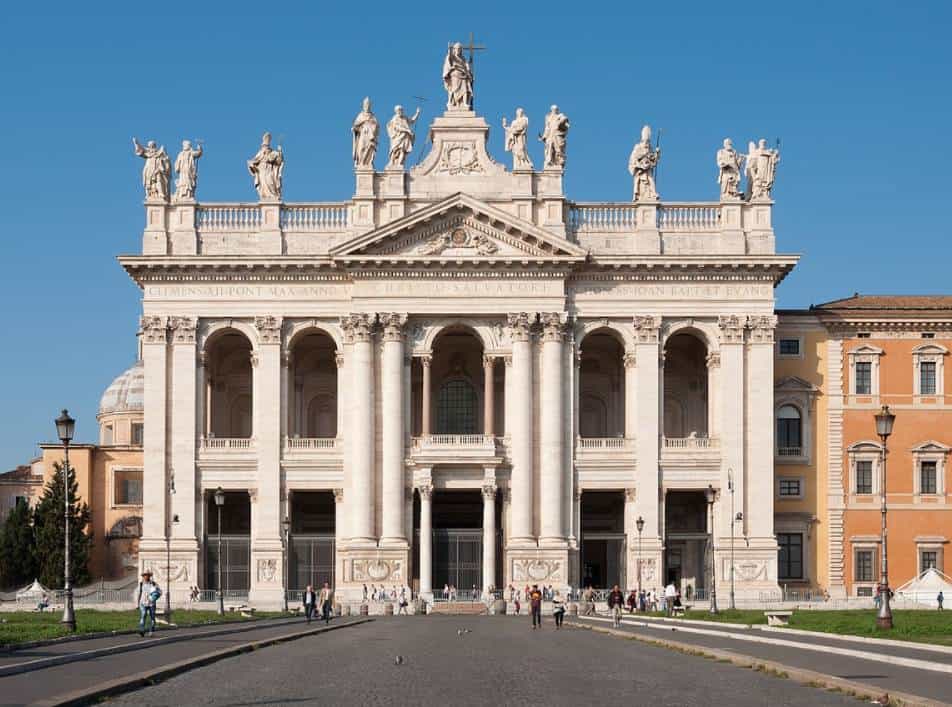Rome is one of those cities that simply breathes history. It’s the closest thing you’ll get to a big open-air museum full of historical landmarks and monuments.
The city is located in the western part of Central Italy and has a population of over 2.8 million inhabitants within its city proper. This makes it the third-most populous city in the European Union.
It’s also one of the oldest cities in Europe with its history spanning about 28 centuries. According to Roman mythology, the city was founded in 753 B.C.
Within the borders of Rome, you can find Vatican City, the papal enclave that is officially considered to be the smallest country in the world, and which is home to incredible art and architectural marvels.
In this post, we made an overview of the most famous buildings in Rome. These are the architectural marvels that you absolutely must check out when visiting the city.
1. Colosseum
The Colosseum is one of the most infamous buildings ever constructed. It was used for fun and entertainment, but that didn’t mean the same as it does today in Ancient Rome.
Gladiator fights and animal hunts were the most popular form of entertainment held in Roman Amphiatheaters all across the empire.
Constructed in the late 1st century under the command of Emperor Vespasian and his sons who succeeded him as rulers of Ancient Rome, Titus, and Domitian, he used the spoils of the sacking of Jerusalem to build the Flavian Amphitheater.
It’s estimated that an incredible half million people and over a million animals lost their lives in horrible ways to the cheers of 50,000 excited Romans at the Colosseum.
Even though still standing, most of the structure lay in ruins today. This doesn’t mean that atmosphere from ancient times can’t be felt when you enter the arena, though.
Visiting the most iconic structure in the city isn’t a bad idea to start your journey in Rome, don’t you think?
Official website: The Colosseum

2. Pantheon
The Pantheon in Rome is a remarkable building for multiple reasons. This former Roman Temple was built as a place to “honor all the Gods” as its name describes.
It was turned into a Catholic Church after the fall of the Roman Empire, which is the main reason this has been preserved so well.
It was commissioned by Marcus Agrippa, a Roman general, and architect, during the reign of Emperor Augustus (27 B.C. – 14 A.D.). That’s the reason it has his inscription in the temple’s portico.
Emperors Trajan and Hadrian continued the construction until it was completed and dedicated in the year 126 A.D.
The temple has a large portico with Corinthian columns and the main structure has the world’s largest unreinforced concrete dome which comes together at a central opening called an oculus at a height of 43 meters (142 feet).
While the area of the fabulous dome of the building looks pretty bleak from the outside, you’ll be remarkably surprised when you enter this incredible structure, that’s a guarantee.
Official website: Pantheon Roma
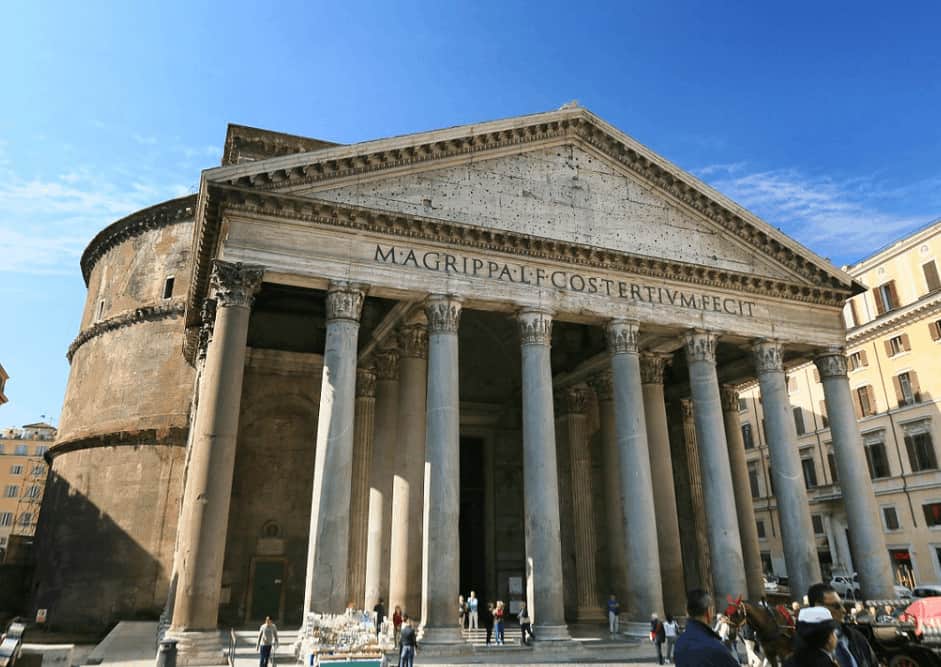
3. Roman Forum
The Roman Forum was the main public square of Ancient Rome, the center of day-to-day life in the city.
It contains the ruins of multiple important buildings of Ancient Rome, including government buildings, statues, and temples.
The citizens of Ancient Rome referred to this square, which used to be a marketplace as well, to the “Forum Magnum,” or simply the “Forum.”
It’s also here that all the triumphal procession of Ancient Rome passed, elections were held, and public speeches were given.
Right now, it’s filled with architectural fragments and sites of excavations. It’s one of the most popular tourist attractions in all of Rome, attracting millions of visitors every year.
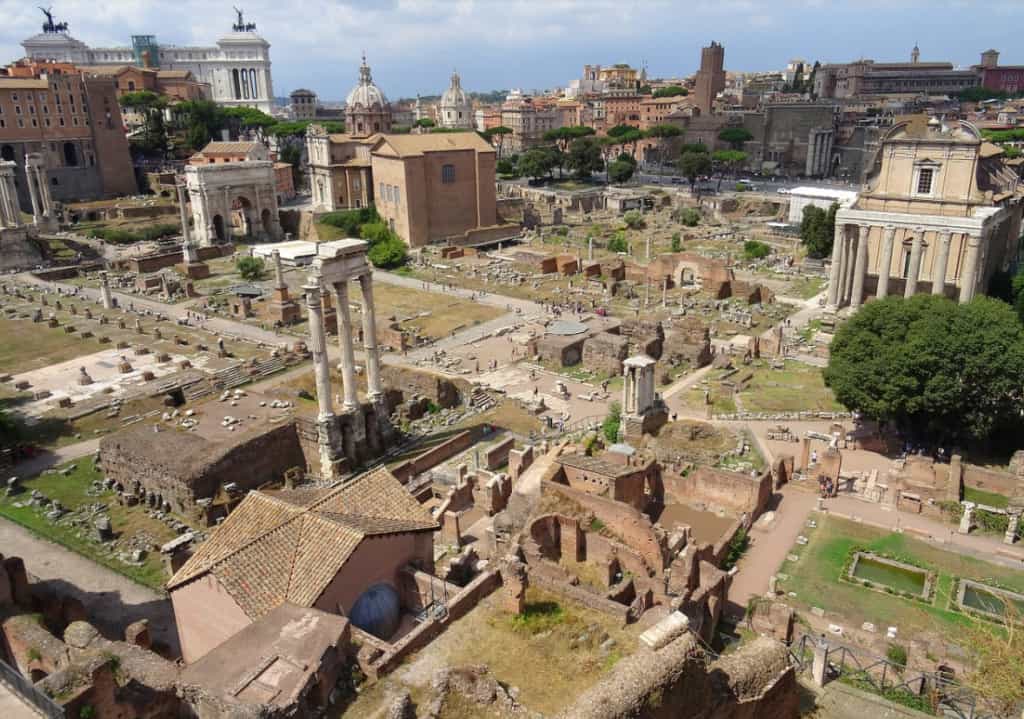
4. Trevi Fountain
The Trevi Fountain is one of the most famous fountains in the world and was named after the district of Rome it’s located in.
It’s an immense Baroque fountain that stands 26.3 meters (86 feet) tall and is 49.15 meters (161.3 feet) wide.
The work on the fountain, which is ornamented with a variety of amazing sculptures, began in the year 1732 and was completed in 1762.
It’s one of the most popular tourist spots in all of Rome and the fountain is famous for coin throwing.
It’s estimated that on average 3,000 euros are thrown into the fountain every day, which in return supports Rome’s poorest people.

5. Vatican Museums
The Vatican Museums are located in Vatican City, a city-state that is enclaved within Rome. It’s one of the world’s remarkable public museums, with art amassed by the Catholic Church for many centuries.
The collection, which consists of 70,000 works of which about 20,000 are on display, and contains some of the most famous Roman sculptures
It’s also home to some of the most important masterpieces of the Renaissance, including amazing paintings from the masters Leonardo da Vinci, Michelangelo, and Raphael.
The museums were founded in the 16th century by Pope Julius II, a contemporary of the 3 artists mentioned.
The museums are visited by nearly 7 million people every year, making it the third-most visited museum in the world behind the Louvre in Paris and the National Museum of China in Beijing.
Official website: Vatican Museums
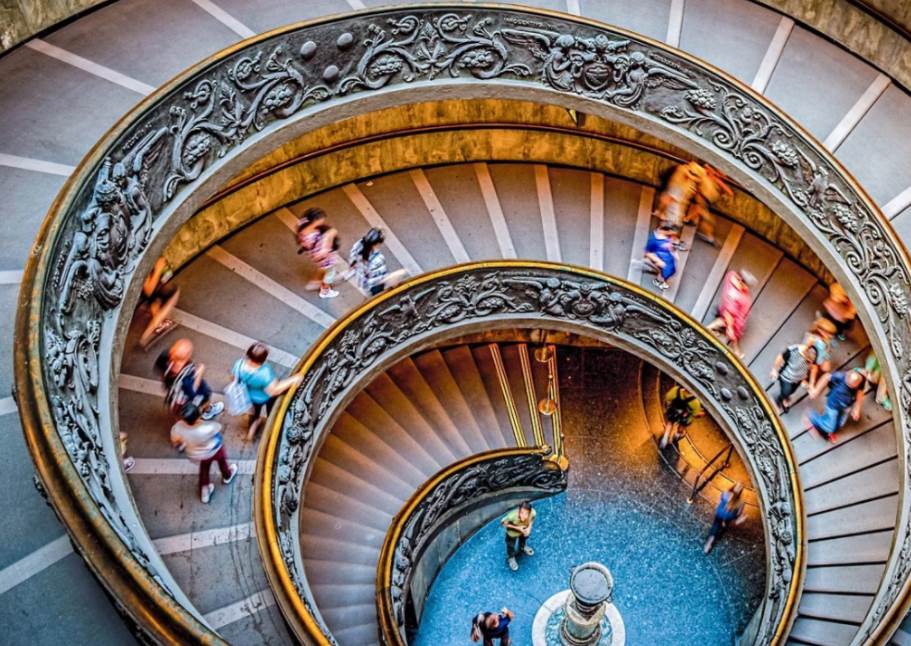
6. St. Peter’s Basilica
St. Peter’s Basilica is located within Vatican City and is the largest Catholic Church in the world.
The church is the epitome of Renaissance architecture and was designed by Donato Bramante and Michelangelo, among several others.
Despite not being the mother church of the Catholic Church or even the cathedral of the Diocese of Rome, it’s considered to be the most important and one of the holiest shrines in the Christian world.
It’s also the largest church in the world and has staggering dimensions. It’s 220 meters (720 feet) long, 150 meters (490 feet) wide, and reaches a maximum height of 136.6 meters (448 feet)!
St. Peter’s Basilica is adjoined by the world-famous St. Peter’s Square and contains numerous pieces of art as well.
One of these masterpieces is Michelangelo’s Pietà, one of the most famous sculptures in the world.
The only thing you can pretty much do is stand in awe and admire this astounding structure!
Official website: The Vatican

7. Sistine Chapel
The Sistine Chapel is the chapel of the Apostolic Palace, the main residence of the Pope in Vatican City.
It’s essentially the final part of the Vatican Museums and is officially called the “Cappella Magna” (Great Chapel).
Its name derives from Pope Sixtus IV (1414-1484), the man who restored it between 1473 and 1481.
Today, it’s mainly used for the Papal Conclave, a gathering of the College of Cardinals to elect a new Bishop or Pope. Yes, it’s from this building that either white or black smoke emerges from chimneys following the decision.
The chapel is world-famous for its amazing frescoes, mainly the Sistine Chapel Ceiling, which includes the iconic “Creation of Adam,” and “The Last Judgement“
The latter covers the entire Altar Wall. Both these frescoes were painted by Michelangelo in the 16th century.
The Sistine Chapel is a structure you simply have to visit once in your lifetime.
Official website: Sistine Chapel

8. Arch of Constantine
The Arch of Constantine is a triumphal arch built in Ancient Rome and is located right next to the Colosseum.
It was constructed to honor Emperor Constantine the Great for his victory over Maxentius at the Battle of Milvian Bridge in 312 A.D.
The arch is located right on the Via Triumphalis, the route in which Emperors entered Rome to celebrate victories.
The arch was dedicated just 3 years after the battle in the year 315 A.D.
The Arch of Constantine was the biggest triumphal arch in Ancient Rome and most of its monumental decorations were taken from various other monuments around the city.
The stands 21 meters (68 feet) tall and is 25.9 meters (4 feet) wide. This makes it an incredible historic monument in the city, although it’s dwarfed by the immense Colosseum nearby.
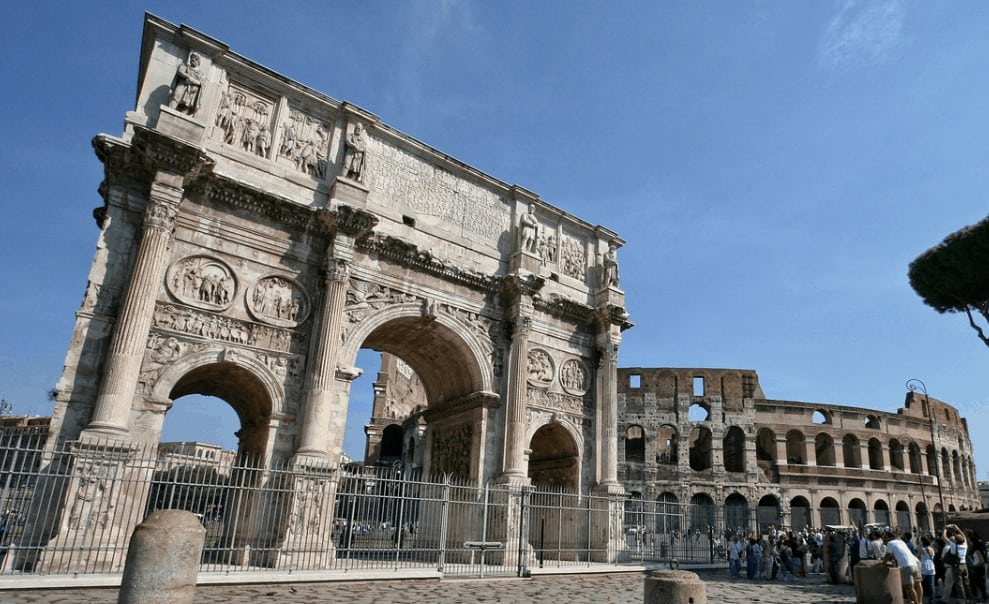
9. Castel Sant’Angelo
The Castel Sant’Angelo translates to “Castle of the Holy Angel” and was originally constructed as a mausoleum for Roman Emperor Hadrian and his family.
Therefore the building has also been referred to as “Hadrian’s Mole.” It was the tallest structure in the city upon completion.
This huge cylindrical building is located on the right bank of the Tiber in Parco Adriano, a park in the center of Rome.
Apart from the remains of Hadrian and his family, the building has also been used to bury the remains of the emperors succeeding him with the last being Caracalla in the year 217 A.D.
After the fall of the Roman Empire, the building was mainly used as a castle and fortress of the Popes in Rome.
Right now, the building is used as a museum called the “Museo Nazionale di Castel Sant’Angelo.”
Because of the elevated position of this famous building in Rome, it’s a great place to get panoramic views of the city as well, perfectly suited to take amazing pictures.
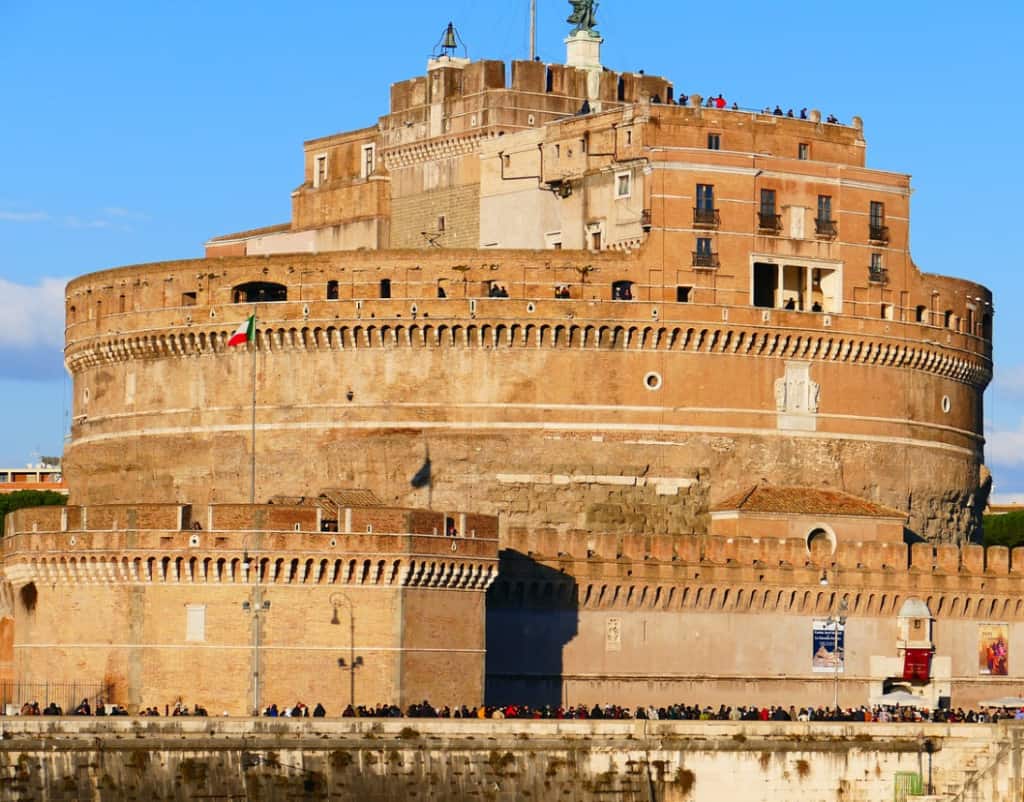
10. Circus Maximus
The Circus Maximus was Ancient Rome’s most famous chariot-racing stadium and mass entertainment venue.
It was located in a valley between the Aventine and Palatine hills in the center of the city.
Apart from the famous chariot-races, the Circus Maximus was also the most popular place for “Ludi,” public games related to Roman religious festivals.
These games could include horse and chariot racing, athletics, plays, beast-hunts, and gladiator fights.
The Circus Maximus was an immense stadium with a capacity of over 150,000 spectators. It was 621 meters (2,037 feet) in length and 118 meters (387 feet) in width.
Today, the area is a public park, a fascinating place to relax in the area of this former ancient Roman entertainment complex.

11. Climb the stairs at the Spanish Steps
The Spanish Steps is a stairway in Rome that leads from the Piazza di Spagna at the base to the Piazza Trinità dei Monti.
At the top of the hill, you can find a church named the Trinità dei Monti church.
There are a total of 135 steps and construction was funded by a French diplomat named Étienne Gueffier who bequeathed 20,000 scudi. The Steps were constructed between 1723 and 1725.
The Spanish Steps are arguably the most famous in the world and have been featured in many movies and television series.
They have a prominent role in the movie The Talented Mr. Ripley (1999) starring Matt Damon.
Climbing this iconic stairway should be on your list of things to do in Rome, that’s for sure.

12. Arch of Titus
The Arch of Titus is another triumphal arch located right on Via Sacra, the main street of Ancient Rome, and just southeast of the Roman Forum, the main square of Ancient Rome.
It was constructed around 81 A.D. during the Flavian Dynasty which consisted of Vespasian (who commissioned the Colosseum), Titus, and his brother Domitian.
The latter commissioned the construction of the Arch of Titus to commemorate his brother and father and honor the sacking of Jerusalem and the victory during the Jewish Rebellion.
The Arch of Titus became the model for numerous triumphal arches that have been constructed since the 16th century
One of the most famous of all is the Arc de Triomphe in Paris which indeed bears a striking resemblance.
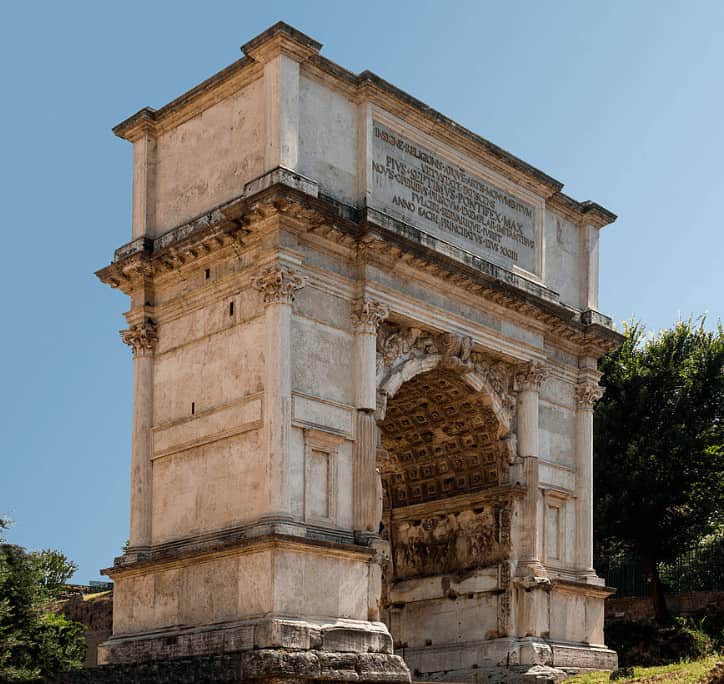
13. Baths of Caracalla
The Baths of Caracalla are the second-largest Roman bathhouse that was ever constructed in Ancient Rome and was one of the largest construction projects of the Roman Empire.
The baths are located just southwest of the historical center of Ancient Rome and south of the Colosseum.
Construction of the baths, which consisted of a lot more entertainment facilities such as a public library, an Olympic size pool, and 2 gyms, started around 211 A.D. during the reign of Emperor Septimius Severus.
The baths were inaugurated during the reign of his son Caracalla in the year 216 A.D.
The baths fell in disuse after Rome was besieged in the year 537 and the aqueducts supplying the water for the baths were destroyed by Germanic tribes.
The site was used as a quarry in the Middle Ages and several important pieces of art were retrieved. these were used to decorate the baths in their glory days.
With a total floor area of 100,000 square meters (1,100,000 square feet) and a height of 40 meters (130 feet), this ancient Roman bathing complex was glorious indeed.
Official website: Terme di Caracalla
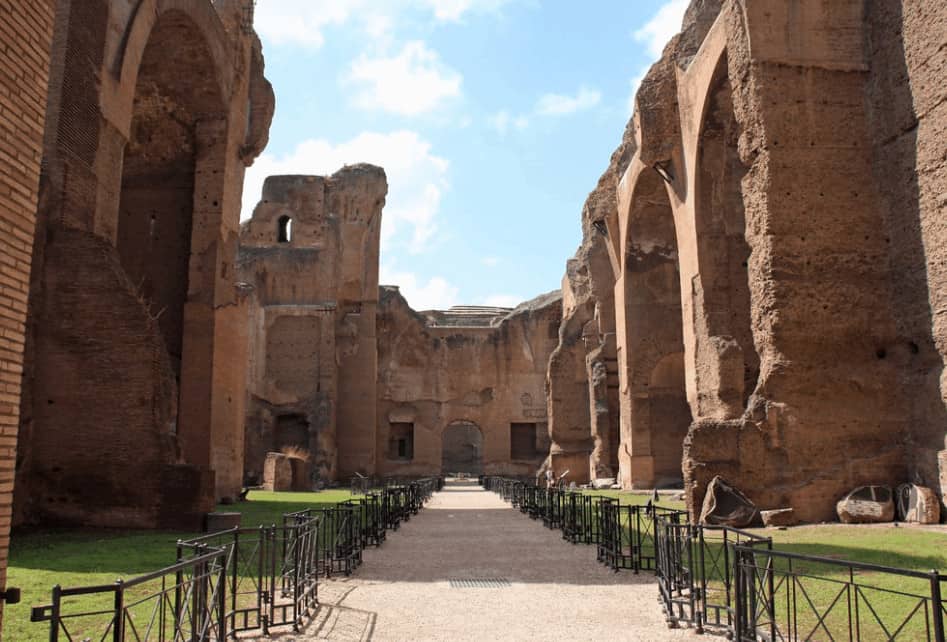
14. Trajan’s Market
Trajan’s market is located on the Via dei Fori Imperiali, right across the Roman Colosseum in the historical center of the city.
It was constructed by Roman Emperor Trajan in the early 2nd century and inaugurated in the year 113 A.D.
It was part of a massive building campaign led by Trajan after he defeated the Dacians in the year 106 A.D. and was able to sack their capital and loot the region.
The market is considered to be a multi-functional structure that included stores, bars, a library, and administrative offices for the emperor.
This remarkably well-preserved ancient structure consists of multiple floors and gives you a great insight into the daily life in Ancient Rome.
There’s a street full of bars that must have been bustling with people in the glory days of the empire, and this complex is one of the few landmarks that give you the impression you’re back in Ancient Rome!
Do you want to walk around in an ancient Roman shopping mall? Then this is the place you can get this fascinating experience.
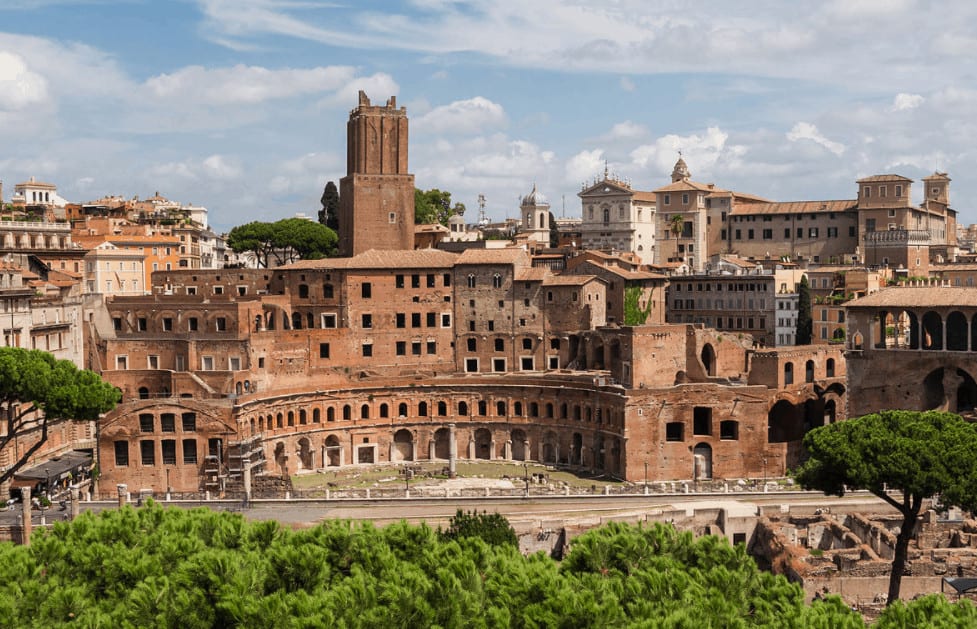
15. Tempietto
The Tempietto translates to the “Little Temple” and that’s what it is. It’s a small temple which is located in the courtyard of the San Pietro in Montorio church in Rome.
It was built in the early 16th century and commissioned by Ferdinand and Isabella of Spain.
This remarkable building was designed by Renaissance architect Donato Bramante and is considered to be one of the most harmonious buildings of Renaissance architecture and an absolute masterpiece of the High Renaissance.
This remarkable structure by Bramante had a great impact on architecture in the following decades and centuries.
It’s believed it served as the inspiration of the famous dome of the St Peter’s Basilica, which in turn became the model for various other iconic domes all around the world.
Yes, this is quite possibly one of the most influential structures from the Renaissance period.
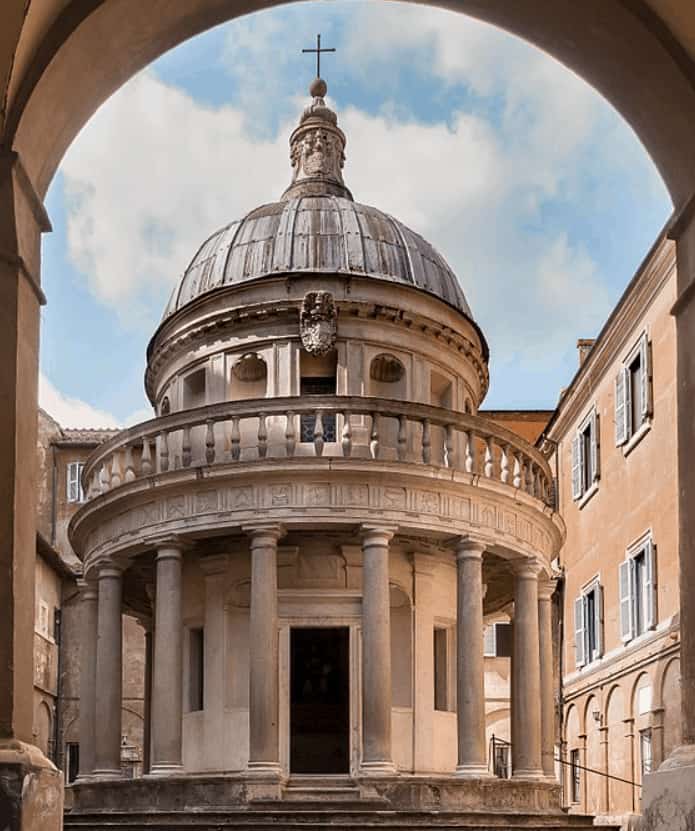
16. Walk around St. Peter’s Square
St. Peter’s Square is one of the most amazing squares in the world, located right in front of the biggest Roman Catholic church ever constructed, St. Peter’s Basilica.
It’s a monumental public space in Vatican City, the papal enclave located in Rome.
It was designed by a man who spent most of his life decorating the interior of St. Peter’s Basilica, Gian Lorenzo Bernini.
The square is dominated by massive rows of Doric Columns, 4 rows deep, and is decorated with an Ancient Roman Obelisk that once decorated the ancient Egyptian city of Heliopolis.
This immense obelisk stands 41 meters (135 feet) and wasn’t moved to Rome until the reign of wacky Emperor Caligula in 37 A.D., quite an amazing attraction in itself.
The square itself was constructed between 1656 and 1667 and has been one of the most remarkable public spaces in the world ever since.
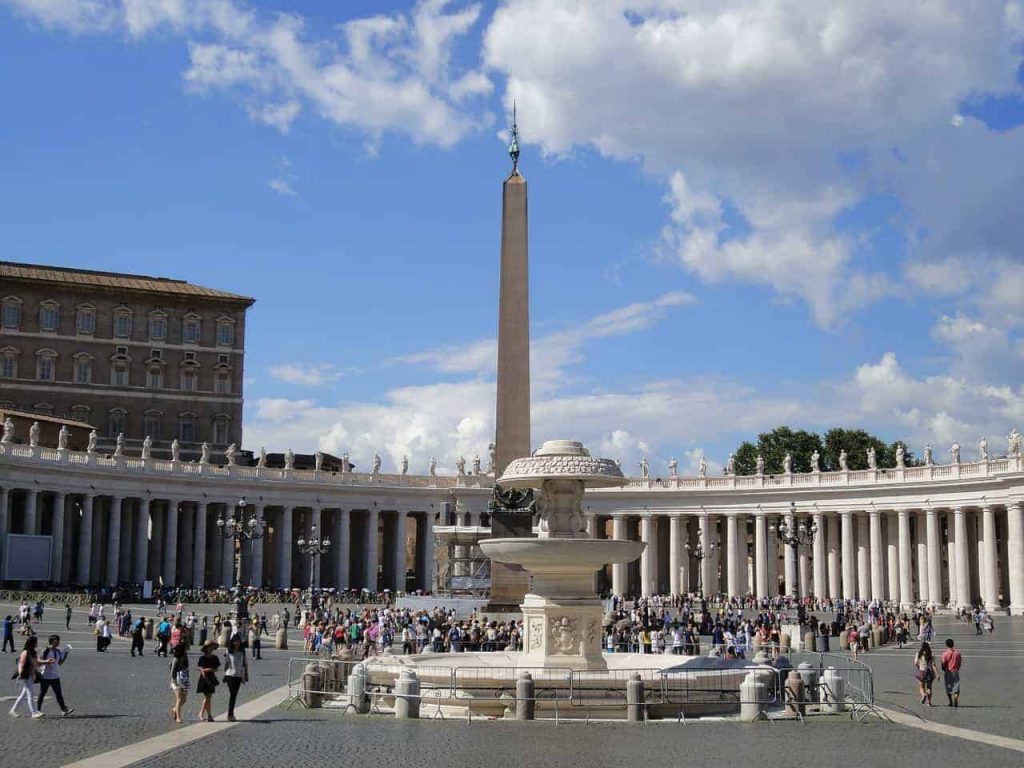
17. Arch of Septimius Severus
The Arch of Septimius Severus is another famous triumphal arch located on the northwestern end of the Forum Romanum.
It was constructed during the reign of Emperor Septimius Severus and dedicated in the year 203 A.D. to commemorate his victory in the Roman-Parthian Wars.
The arch very much resembles the arches built by previous Roman Emperors and features multiple reliefs and sculptures about the wars fought against the Parthian Empire.
This remarkably well-preserved triumphal arch stands 23 meters (75 feet) tall and is about 25 meters (82 feet) wide.
These dimensions make it a very prominent landmark on the ancient Roman marketplace.

The Piazza Navona is another monumental square in the center of Rome. It was built on the former site of the immense Stadium of Domitian
This was a chariot-racing arena that was completed in the first century A.D., and the square has the shape of the former entertainment center of ancient Rome.
Some of the remains of this ancient stadium can be found at the edges of the square, a remarkable sight in a modern-day city.
Before it was referred to as the Stadium of Domitian it was called the “Circus Agonalis,” a reference to the word “agones,” or “games.”
One of the most fascinating monuments on the square is the “Fontana dei Quattro Fiumi” or “Fountain of the Four Rivers.”
This was created by Gian Lorenzo Bernini, one of the most famous sculptors of the 17th century.
It features an ancient obelisk as well which dates back to the reign of Emperor Domitian in the late 1st century A.D.
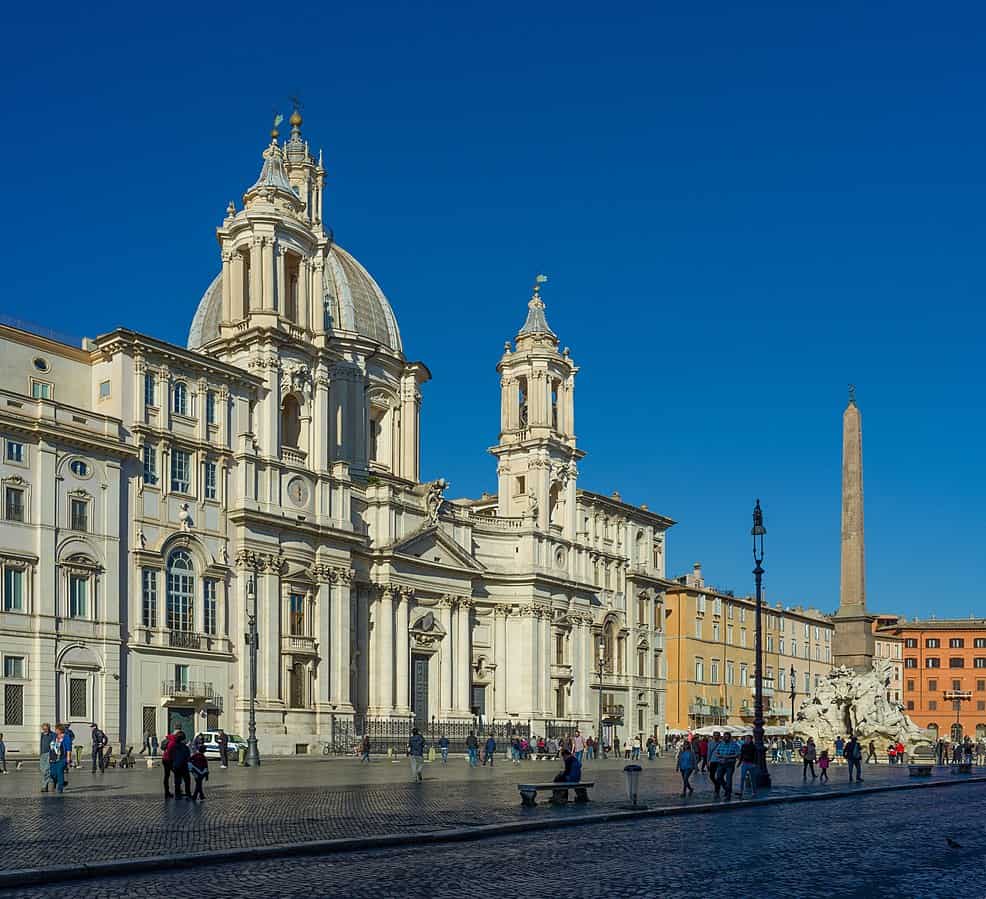
19. Baths of Diocletian
The Baths of Diocletian were another public bath and entertainment complex of ancient Rome.
They were constructed during the reign of Emperor Diocletian between 298 AD and 306 AD and were commissioned by his co-emperor Maximian.
This was considered to be the biggest bathing complex ever built in ancient Rome, covering an area of 13 hectares (32 acres).
Especially the central part of the complex was built on an incredible scale with dimensions of 280 (910 feet) by 160 meters (520 feet).
The remains of the baths are located on the northeast summit of the Viminal Hill, the smallest of Rome’s 7 hills.
The complex was the largest bath complex ever constructed in ancient Rome and was active until the year 537, the year that the Ostrogoths destroyed the aqueducts supplying the water for the complex.
Today, the site is occupied by remains of the ancient complex, the Church of San Bernardo Alle Terme which uses architectural elements of the baths into its design.
If you want to discover ancient archaeological treasures, then you can visit the National Roman Museum. This museum has various findings dating back to ancient times on display.
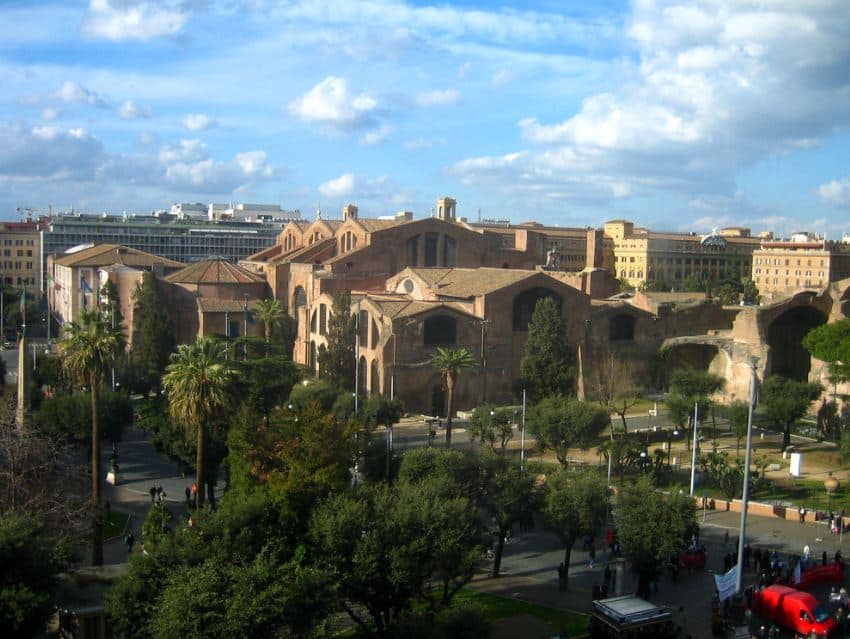
20. Palazzo Farnese
The Palazzo Farnese, also known as the “Farnese Palace,” is one of the most fascinating palaces in the city of Rome.
It was commissioned by the wealthy Farnese family in the year 1517, the high point of the High Renaissance, and seriously expanded in the year 1534.
It’s located on the Piazza Farnese in the Regola district of Rome.
During this expansion phase, the architect of the building was nobody else than Michelangelo, one of the most famous Renaissance artists in history.
The structure was meant to emphasize the importance of the Farnese family, and most importantly that of Pope Paul III himself.
The building got into the hands of the French Government in the year 1874. It was seized, however, by the Fascist government of Benito Mussolini and is now on loan to the French Government for a symbolic euro.
The building serves as the French embassy in Rome today and is worth a visit.
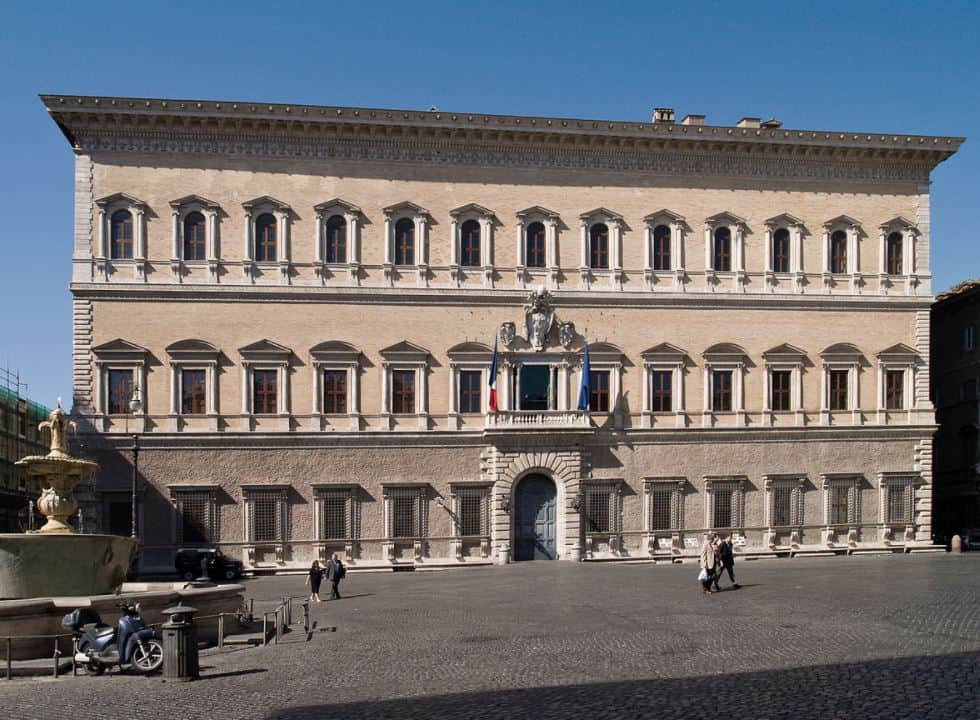
21. Mausoleum of Augustus
The Mausoleum of Augustus is one of the most famous buildings in Rome, mainly because it was constructed by the First Roman Emperor in 28 B.C.
It served as his monumental tomb and was one of his first building projects to be completed. It has a diameter of 90 meters (295 feet) and had an estimated height of 42 meters (137 feet), quite a huge building.
The structure is located on the Piazza Augusto Imperatore on the Campus Martius in Rome, just north of the historical center of the city.
It can be found right in between the San Carlo al Corso church and the Museum of the Ara Pacis, the monumental altar built by Augustus to commemorate the peace he brought to the Empire.
The Mausoleum complex has been completely restored between 2017 and 2021 and has been opened to the public again since March 1, 2021.
It’s bound to become one of the most popular tourist attractions in Rome as it’s the first time since the 1970s that the structure is accessible to the public.
Official website: Mausoleum of Augustus

22. Trajan’s Column
Trajan’s Column is a huge victory column located on Trajan’s Forum, a public space of ancient Rome constructed by Emperor Trajan in the early 2nd century A.D.
It’s located just to the north of the Roman Forum and right across Trajan’s Market, the ancient shopping mall.
The column is fascinating because it has a spiraling bas-relief that depicts 155 scenes of the victory of the Romans in the Dacian Wars, the reason why it was constructed between 107 and 113 A.D.
The column is huge as it stands over 35 meters (115 feet) tall and has a diameter of 3.7 meters (12.1 feet).
There’s a spiraling staircase inside which leads to the top of the monument as well.
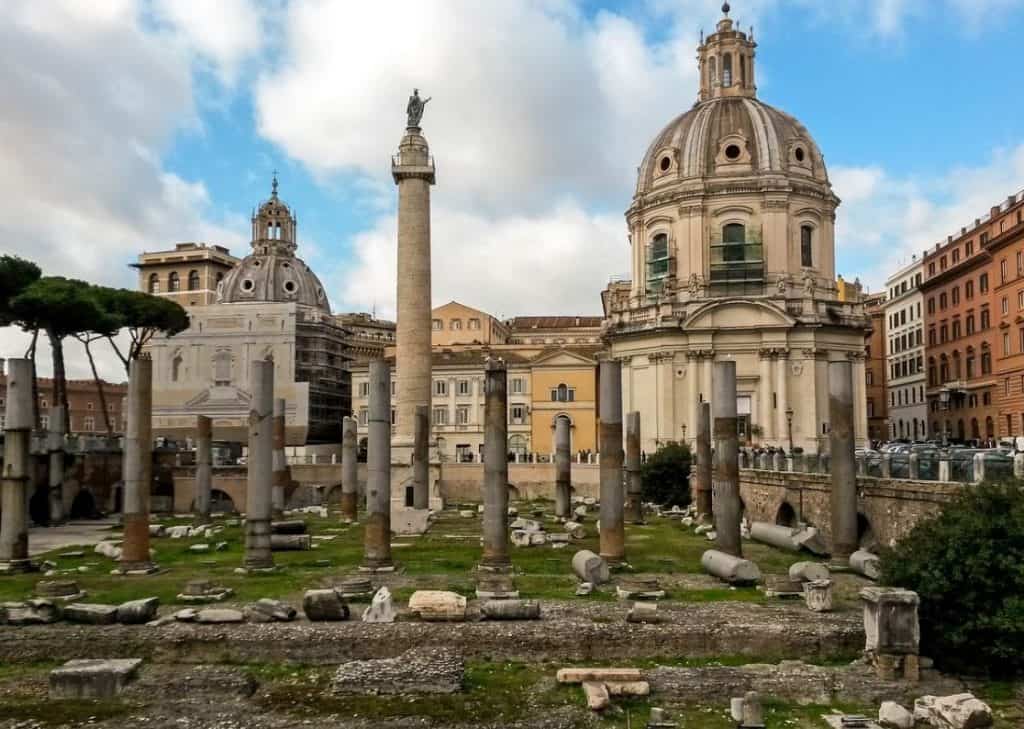
23. Galleria Borghese
The Galleria Borghese is one of the most famous art galleries in Rome and is located in the former Villa Borghese Pinciana.
The Villa is located on the Pincian Hill in Rome and is situated within an immense pubic park of 80 hectares (197.7 acres).
This immense landscaped public park was originally part of the Galleria complex but is now a separate tourist attraction in Rome.
The landscaping of the park as it looks today was completed in the 18th century after originally being designed by Cardinal Scipione Borghese in the early 17th century.
The Villa Borghese was used as a party house on the edge of Rome and as a place to store the Cardinal’s art collection of paintings and sculptures.
He was one of the early patrons of Gian Lorenzo Bernini, one of the most famous sculptors in history who designed St. Peter’s Square.
The art collection also features works of Carravaggio, Veronese, and Rubens, and is a must-visit museum in Rome if you enjoy admiring fine art.
Official website: Galleria Borghese

24. Basilica of Maxentius
The Basilica of Maxentius is also known as the “Basilica Nova” or the “Basilica of Maxentius and Constantine” and is an ancient structure located in the Roman Forum.
It was built in the early 4th century during the reigns of Roman Emperors Maxentius and Constantine I.
Apart from being the largest building constructed on the Roman Forum, it was also the final Basilica built in the city of Rome.
It has a very simple rectangular design and featured an open space in the center which was used for a wide variety of purposes.
The most remarkable feature of this large structure is the fact that it was built using arches, something often used in bathhouses but not in basilicas.
This allowed the central open space to be much bigger as it didn’t require columns for support, a remarkable sight to behold.

25. Victor Emmanuel II Monument
The Victor Emmanuel II National Monument is also referred to as the “Altare della Patria” or “Altar of the Fatherland” and is a huge national monument
It was built in honor of King Victor Emmanuel II, the first king of a united Italy between 1861 and 1875 since the 6th century.
The monument is located between the Piazza Venezia and the Capitoline Hill in the center of Rome and its construction started in 1885.
Even though the monument was inaugurated in 1911, it wasn’t fully completed until 1935.
The structure was built as a forum in itself, similar to the agoras of ancient Greece and Rome.
It features three levels with the top level being characterized by a portico featuring a massive colonnade. This makes it one of the most amazing buildings in Rome and an impressive attraction to visit!
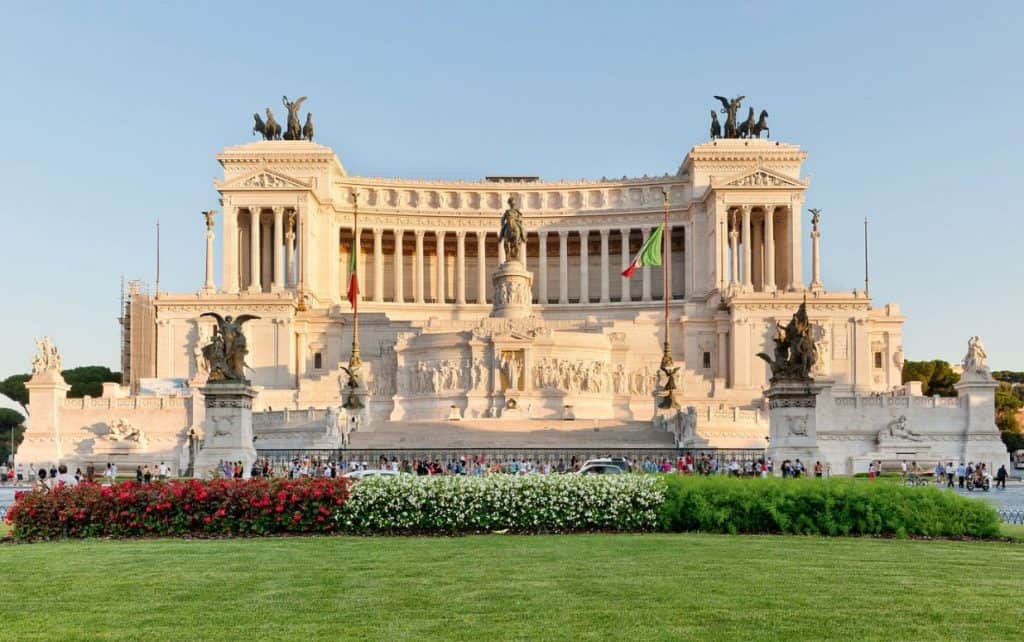
26. Marcello Theater
Marcello Theater is also referred to as the “Theater of Marcellus,” is an ancient Roman open-air theater that was completed at the start of the Roman Empire.
It was formally inaugurated by Augustus himself in the year 12 B.C. after construction had started at the end of the Roman Republic.
Even though it’s hard to imagine today, the theater was huge as it had a diameter of 111 meters (364 feet), the equivalent of a large football pitch.
The theater was the most important of its kind in ancient Rome and was named after Augustus’ nephew Marcus Claudius Marcellus who had died in 23 B.C.
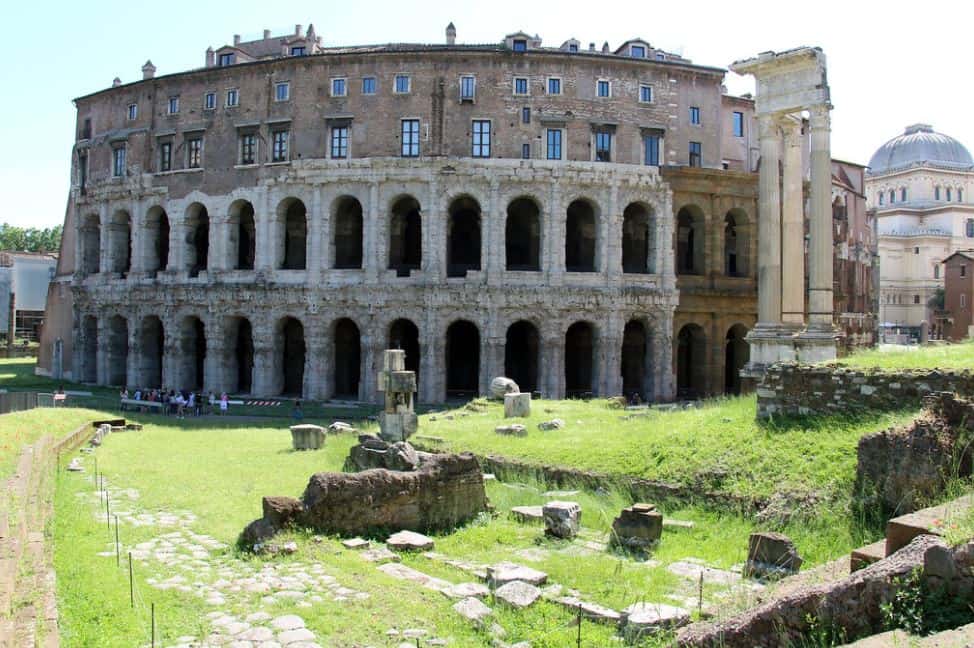
27. Temple of Portunus
The Temple of Portunus is also referred to as the “Temple of Fortuna Virilis” (manly fortune) and is one of the most remarkable little structures from ancient Rome.
Not because of its enormous size but for the fact that it’s one of the best-preserved ancient temples in the city of Rome.
Its history remains a bit obscure as it’s not certain to who the temple was dedicated.
It could be that it was dedicated to Portunus, the god of keys, doors, and livestock, but the temple was referred to as the Temple of Fortuna Virilis since the Renaissance.
Either way, the original temple on this site was built around the 3rd or 4th century B.C. but was rebuilt between 120 and 80 B.C.
It’s located on the Forum Boarium, the location of the original docks of the city of Rome.
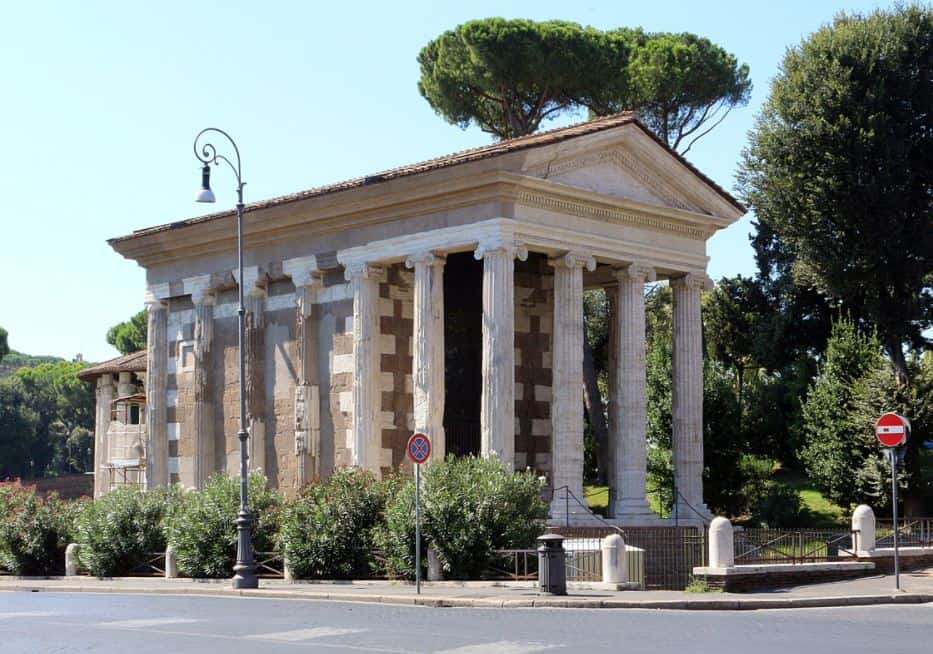
28. Basilica Papale di Santa Maria Maggiore
The Basilica Papale di Santa Maria Maggiore is a major basilica church located near the Termini Railway Station and just northeast of the Roman Forum.
It’s the largest Catholic Marian church (a church dedicated to the venerated Virgin Mary) in the city with a length of 92 meters (302 feet) and maximum width of 80 meters (260 feet).
The church is remarkable in the sense that even though it’s not located in Vatican City, it’s still fully owned by the Holy See.
This remarkable church was completed in the year 1743 and was amazingly decorated in the Baroque architectural style.
The highlights inside the church are 5th-century mosaics that depict scenes from the life of the Virgin Mary, and gilded ceilings with gold presumably brought to Italy by Christopher Columbus.
The exterior of the church also features a campanile with a height of 75 meters (246 feet), the highest in all of Rome.
Other important features are the extremely opulent Borghese Chapel and the “Salus Populi Romani,” a Marian image that arrived in Rome in 590 A.D. and which is considered to be the oldest in Rome.
Official website: Papal Basilica of Santa Maria Maggiore
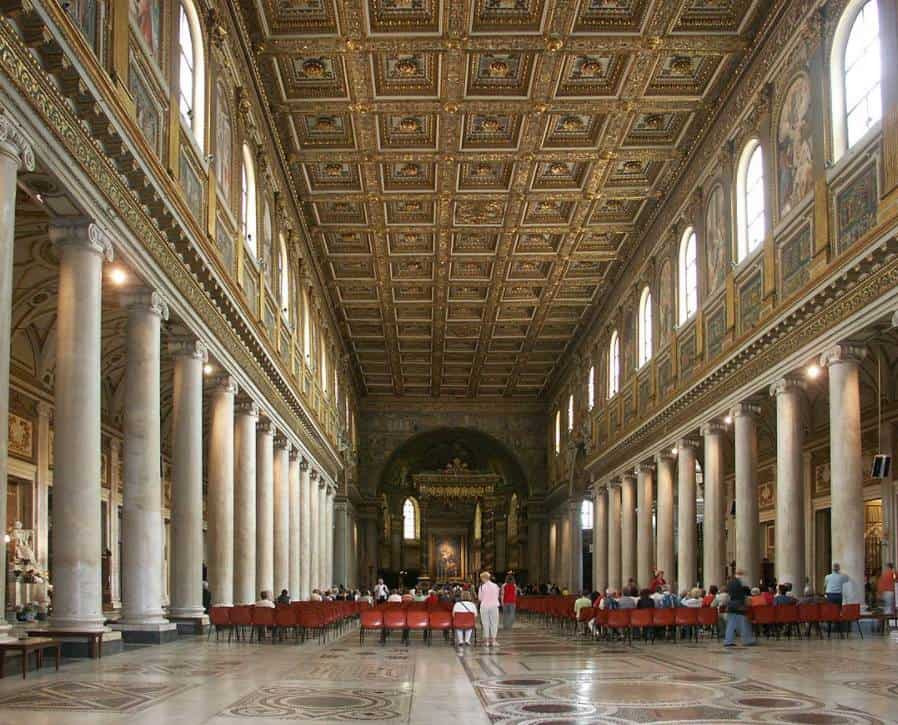
29. Capitoline Museums
The Capitoline Museums is the name of a collection of museums located on Capitoline Hill, one of Rome’s 7 historic hills.
This hill is located right in between the Campus Martius and the Roman Forum, which pretty much means the historic heart of Rome.
The three main buildings of the museum are the Palazzo dei Conservatori, Palazzo Senatrio, and Palazzo Nuovo, all of which face the Piazza del Campidoglio on top of the hill.
The collection of the museum originally started in 1471 when Pope Sixtus IV was given a great collection of bronze ancient Roman statues.
The museum opened its doors much later in 1734 but is regardless considered to be the first museum open to the public in history.
Since then, the collection of the museum has grown significantly and features a wide variety of ancient Roman sculptures, coins, and numerous other artifacts.
While ancient Roman exhibits make up most of the museum, it also features a collection of medieval and renaissance art.
Official website: Capitoline Museum

30. Villa Borghese park
Villa Borghese is the name of the huge park that was developed to serve as the garden of the “Villa Borghese Pinciana,” now known as the Galleria Borghese.
The park covers an area of 80 hectares (197.7 acres) which makes it the third-largest public park in Rome.
Even though the gardens were originally designed based on sketches made by Scipione Borghese himself, the gardens we see today were designed in the 18th century.
The park is located just north of Rome’s historical heart and is one of the best places in the city to enjoy a relaxed afternoon.
Especially the scenic lake near the “Temple of Asclepius,” an Ionic Temple that was built in 1786, offers great scenery.
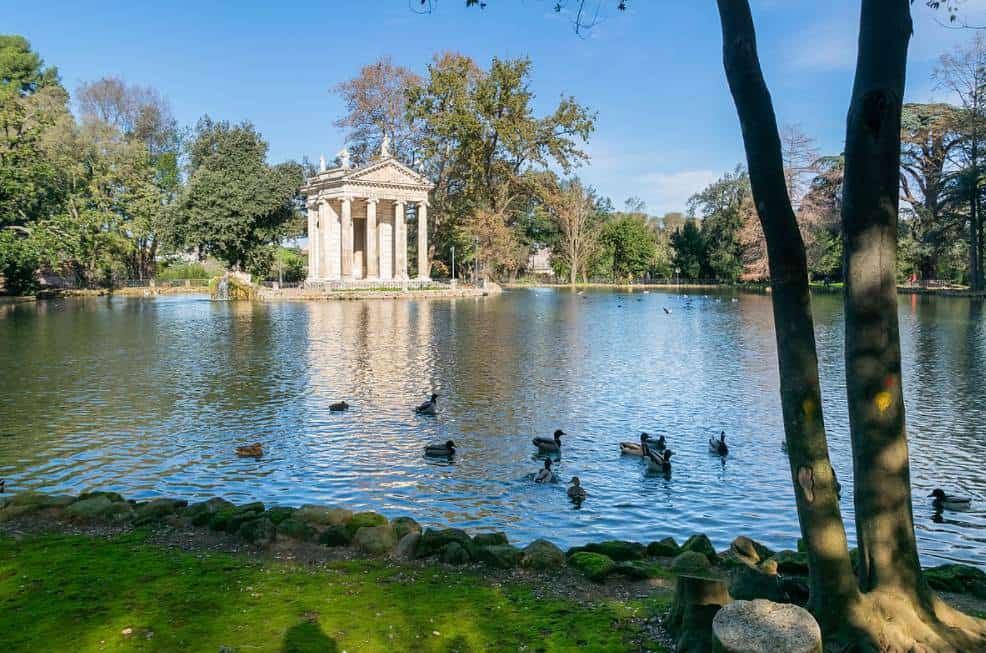
31. Walk around the amazing Piazza del Popolo
Piazza del Popolo translates tot he “People’s Square.” The original name, however, was derived from a type of plant named “Populus” in Latin.
Regardless of its innocent-sounding name, the square has traditionally been the location of public executions. It served this purpose for numerous centuries until the final one in 1826.
In that sense, the square can be compared to the Place de la Concorde in Paris which served a similar purpose during the French Revolution in the late 18th century.
The square is situated in what used to be the northern gate of the Aurelian Walls of Rome, originally called the “Porta Flaminia” (about the ancient Roman road “Via Flaminia) and now referred to as the “Porta del Popolo.”
The huge square is located just west of the Villa Borghese gardens and is decorated with an ancient Egyptian Obelisk in the center.
This obelisk originally decorated the ancient Egyptian city of Heliopolis and was commissioned by Ramesses II during the 13th century B.C.
It’s a great place to walk around, that’s for sure.
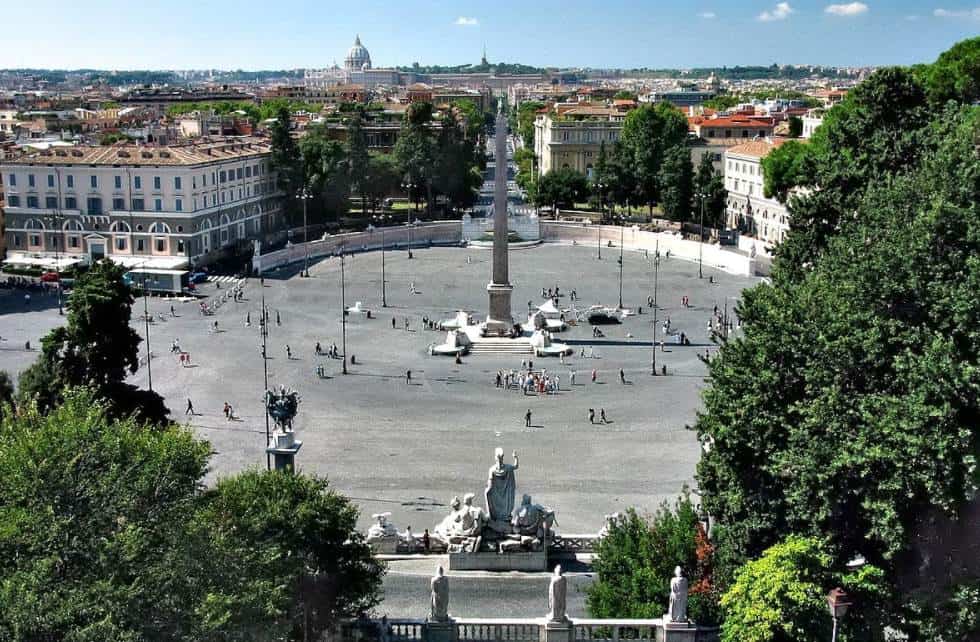
32. Campo dei Fiori
A rectangular square named “Campo dei Fiori” can be found just south of the famous Piazza Navone, just west of the Pantheon.
The area wasn’t developed yet in ancient times and the name of the square, which translates to “field of flowers,” refers to how the area looked back then and well into the Middle Ages.
The square also has a dark side because it was also a place for public executions, including philosopher Giordano Bruno who was burned alive here in 1600. His statue now decorates the center of the square.
Today, the meadow has been replaced by a picturesque public square that features a daily market with fruits, vegetables, and a wide variety of spices.
The daily market has been active since 1869, shortly after a block of houses was demolished in 1858 to enlarge it.
It’s one of the best places to spend the evening as well as this place is bustling with tourists and locals alike.
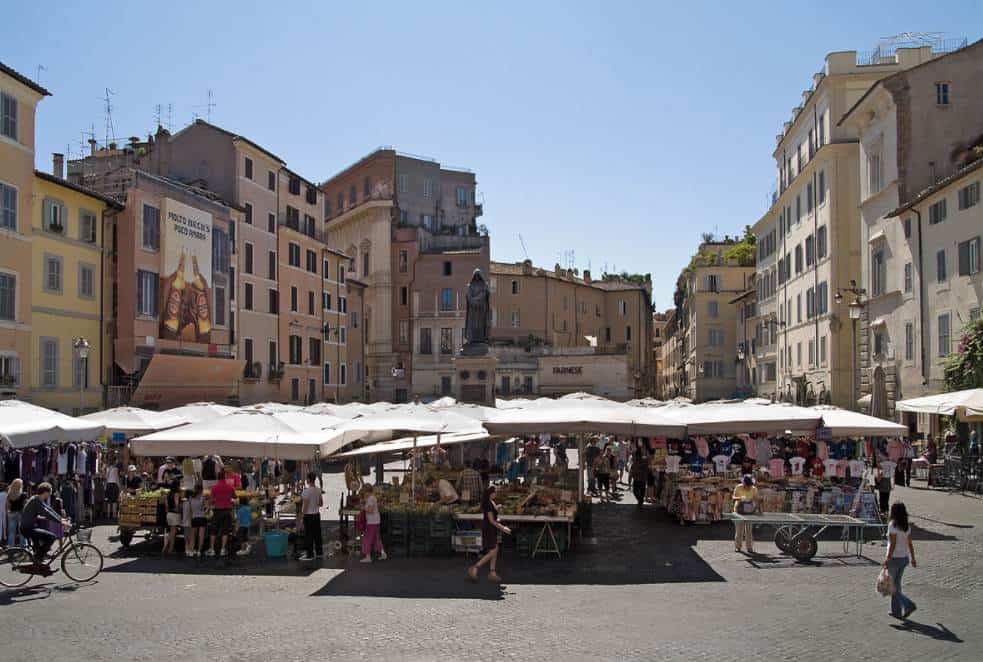
33. MAXXI
The Museo Nazionale delle Arti del XXI Secolo or “National Museum of 21st-Century Arts” si commonly known as “MAXXI” and is located in the Flaminio district of the city.
The building in which the museum is housed was designed by renowned architect Zaha Hadid and looks amazing among the copious amounts of historic buildings located in the city.
Building the museum took a decade, which is longer than many of the biggest ancient Roman monuments. It finally opened its doors in 2010.
The museum features two distinctive sections called “MAXXI art” and “MAXXI architecture,” and the space just outside of the museum is reserved for large works of art.
The museum solely focuses on contemporary art and features works from many of the most renowned artists in the world.
Official website: MAXXI
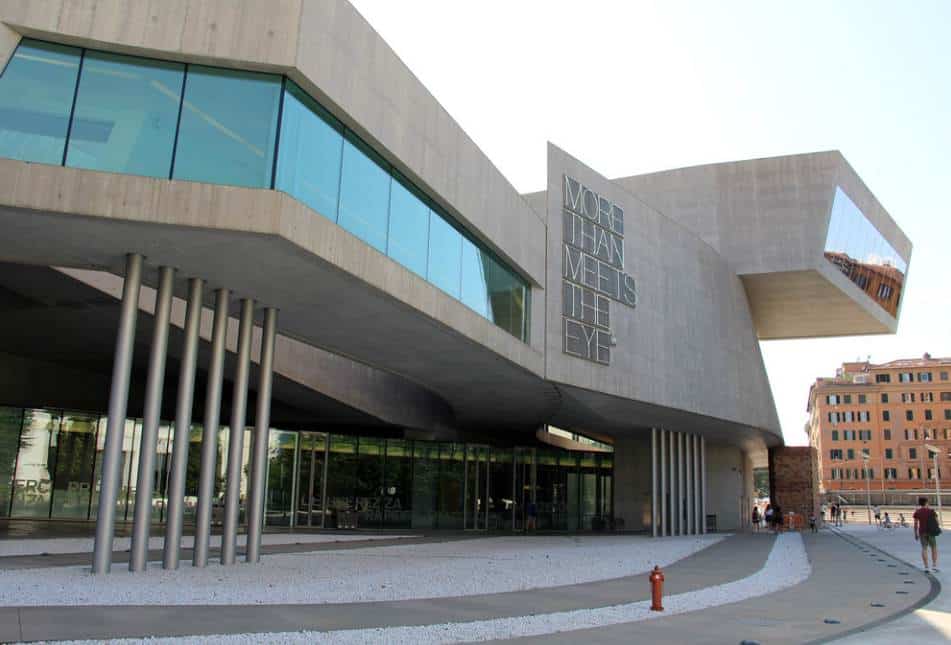
34. Campidoglio
Even though the main attraction on top of Capitoline Hill is the Capitoline Museums, the buildings of this complex are located on a remarkable square.
This square is called “Campidoglio” as well and was designed by Michelangelo between 1536 and 1546.
Even though he made the design in the 16th century, it would take nearly 4 centuries before his plans were fully realized. This also means that not much was done during Michelangelo’s lifetime.
One of the most remarkable things he did was to reverse the main direction of the square, away from the ancient Roman Forum and facing St. Peter’s Basilica.
The center of the square is decorated with a huge equestrian statue of Marcus Aurelius, the “philosopher emperor” made of bronze. The original is located inside the museums while the one on the square today is a replica created in 1981.
It’s fair to conclude that only a genius like Michelangelo could turn an uneven hill full of crumbling medieval structures into the magnificent square we see today.

35. St. Clement Basilica
St. Clement Basilica is officially known as “San Clemente al Laterano” and was dedicated to Pope Clement I, the 4th Bishop of Rome between 88 and 99 A.D.
Even though the current church dates back to the late 11th century, it was built on the ruins of multiple much older structures.
It’s believed this was the location of one of the oldest Catholic churches in Rome, built in the 1st century A.D. his church was built on top of an even older villa dating back to the Roman Republic era.
On this ancient Roman’s house, another church was built in the 4th century of which the ruins can still be seen beneath the present-day church.
The church isn’t too far from the Colosseum and visiting the excavation site of the ancient church below the medieval version is quite an amazing experience.
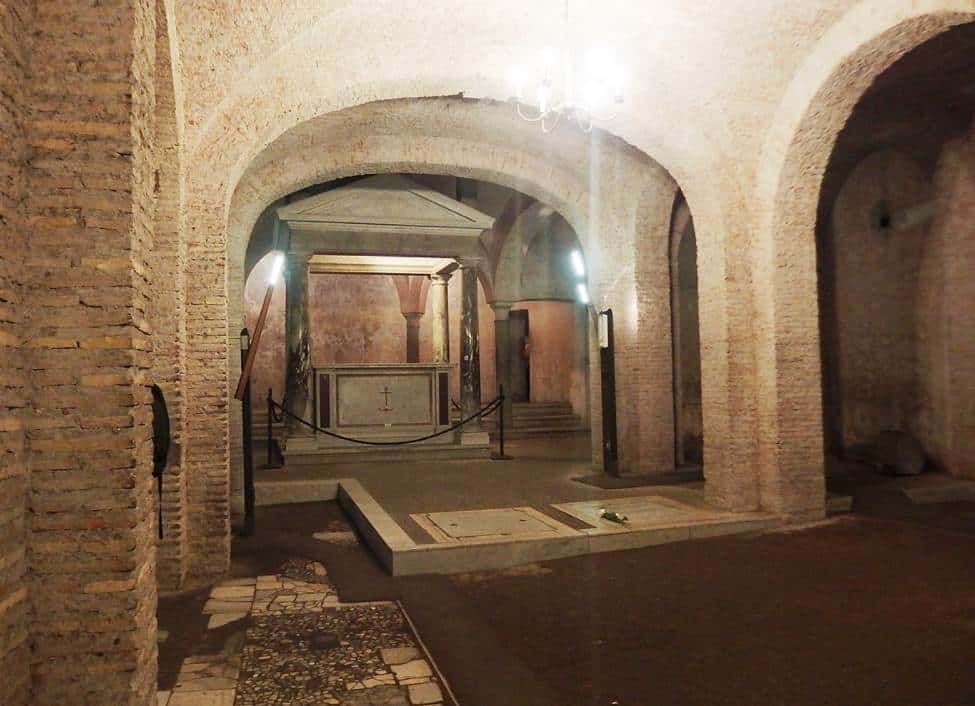
36. Domus Aurea
One of the most infamous figures in Roman history was Emperor Nero, a madman who ruled over the Roman Empire for nearly 12 years between 56 and 68 A.D.
His reign was defined by craziness, cruelty, and extravagance, and the epitome of the latter was his so-called “Golden House” or “Domus Aurea.”
This structure replaced an older palace he had built called the “Domus Transitoria,” but this was destroyed during the Great Fire in Rome of 64 A.D.
The entire complex covered a total of 2.6 square kilometers (about 1 square mile) and was most probably never completed because Nero forcibly killed himself in 68 A.D.
The golden house was completely stripped of its jewelry, marble, and other expensive materials, and nothing more than the roughly finished ruins can be seen today.
Nevertheless, this first-century structure remains a remarkable remembrance of one of the most notorious rulers in human history.
Guided tours inside the golden palace can be arranged on the weekends.
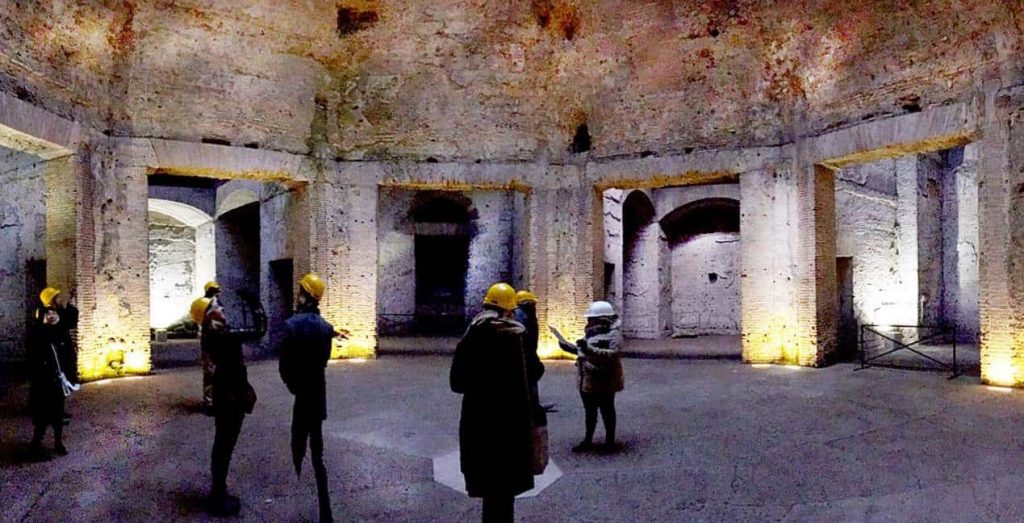
37. Doria Pamphili Gallery
One of the most fascinating collections of fine art in Rome is housed in an extravagant palace known as the Palazzo Doria Pamphilj.
The palace is located on the Via Corso, one of the main streets in Rome’s historical center.
The palace and collection are owned by the families Doria, Pamphilj, Landi, and Aldobrandini, who have united through marriage and went by the surname Doria Pamphili.
The start of the art collection dates back to the 16th century and contains some of the most amazing works of fine art in the world. These include works by renowned artists such as Raphael, Caravaggio, Titian, and Diego Velázquez.
What’s remarkable about this huge palace is that it’s still privately owned by the same family.
Today, the art collection is housed in the Doria Pamphilj Gallery which is open for tours. Both the artworks and the setting in which they are housed are breathtaking.
Official website: Galleria Doria Pamphili

38. Be amazed at the Pyramid of Caius Cestius
Pyramids are associated with Egypt, even though they have been built in various other countries in the world as well.
You don’t expect to come across ancient Pyramids in Rome, though, which makes this remarkable monument all the most fascinating.
The Pyramid of Cestius is located near the Porta San Paolo in the southern part of the city. Just like the pyramids of ancient Egypt, this one was built to serve as a tomb for the man who commissioned it, a Roman magistrate named Gaius Cestius.
The huge structure was completed between 18 and 12 B.C. and has a diameter of 29.6 meters (97 feet). It’s also much higher than it initially appears to be as it stands 37 meters tall (121 feet).
Tet tomb inside the pyramid was opened for the first time in 1660 was empty at the time. Not much of the frescoes that decorated the walls are visible as well.
The structure you see but against it is part of the Aurelian Wall. The pyramid was simply incorporated into it, not a bad idea, right?
Regardless, it’s possible to enter the pyramid on specially arranged tours every third and fourth Saturday of the month.
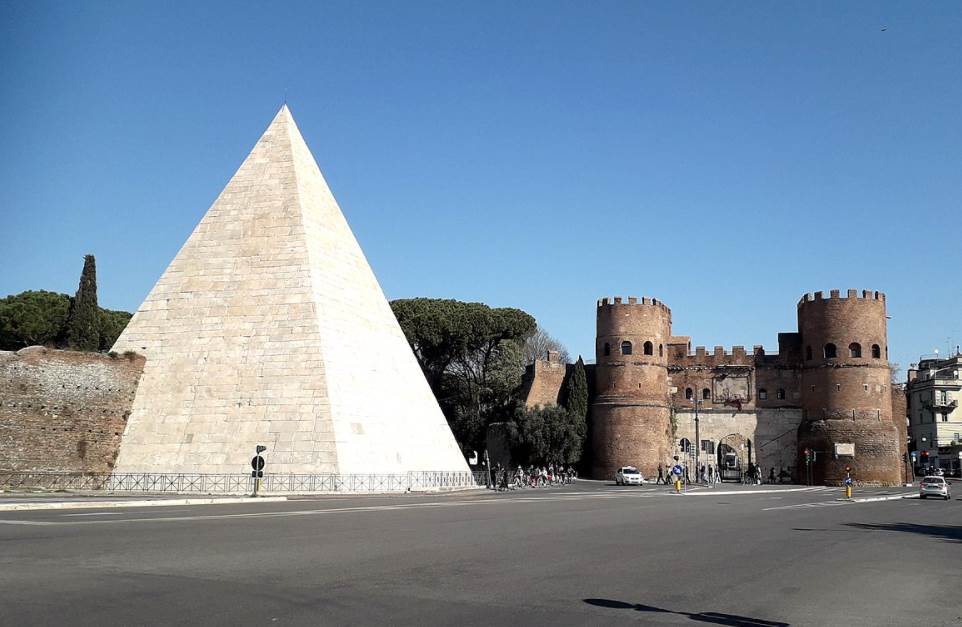
39. Explore the National Etruscan Museum of Villa Giulia
So who came before the Romans? The answer is the “Etruscans.”
Even though the Etruscan civilization didn’t even come close to ruling over the land that the Romans eventually did, they lived in the area around Rome between 900 and 27 B.C.
They didn’t leave either because they were simply granted Roman citizenship between 90 and 27 B.C.
If you want to learn everything about the predecessors of the ancient Romans then you can head over to the Villa Giulia just north of Villa Borghese.
This mansion was built by Pope Julius III between 1551 and 1553 and now houses the National Etruscan Museum.
This museum is full of treasures and artifacts dating back to the period that the forgotten Etruscans called Rome their home.
Official website: National Etruscan Museum
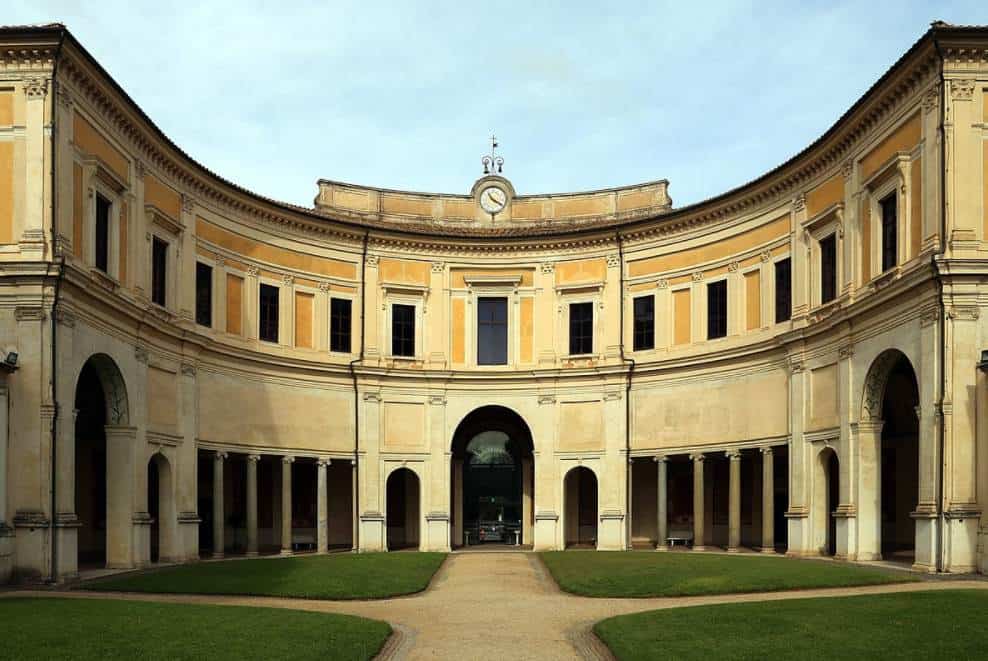
40. Marvel at the Basilica di Santa Maria in Ara coeli frescoes
On the summit of Capitoline Hill, there’s a remarkable church that was originally completed in the 12th century.
This church is known as the “Basilica of St. Mary of the Altar of Heaven” and is the designated church of the city council of Rome.
The major attraction inside the church is a shrine that holds relics that belonged to Saint Helena, the mother of Constantine the Great, the first Roman Emperor who converted to Christianity in the 4th century.
In our opinion, the main reason to climb the steps to the top of the summit in order t visit the church is its remarkable interior.
The church features two aisles lined with Roman columns and the wooden ceiling is magnificently decorated with frescoes, quite an amazing sight after a tiring walk up the steps.
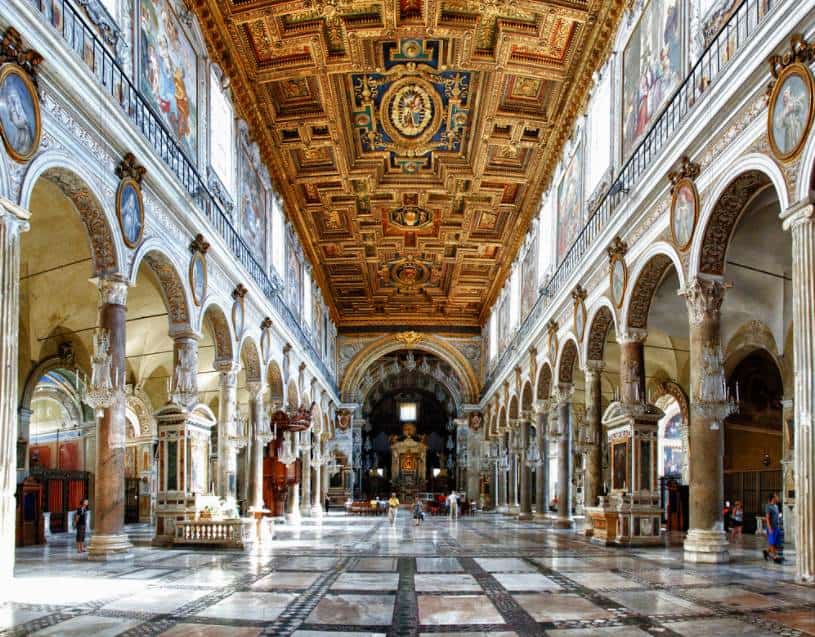
41. Walk across the historic Milvio Bridge
The “Ponte Milvio” or “Milvio Bridge” is the location where an important event in Roman history took place in 312 A.D., the “Battle of the Milvian Bridge.”
During this battle in the northern part of the city, Constantine I defeated Emperor Maxentius which led to his ultimate rule.
The original bridge in Rome was built in 206 B.C. and was replaced with the first stone bridge less than a century later in 109 B.C.
This bridge lasted for countless centuries until it was renovated during the Middle Ages and completely rebuilt during the 18th and 19th centuries.
Even though the amazing bridge is only 136 meters (446 feet) long, the extensive history of the bridge makes this a remarkable place to cross the Tiber River.

42. Window Shop at the Via Condotti
Milan has the Via Montenapoleone, Rome has its version of a high-end shopping street full of expensive brands called the Via Condotti.
The street starts right at the foot of the Spanish Steps and runs all the way southwest to the Tiber River in the heart of the city.
The name of the street dates back to ancient Roman times when water was carried along this way to the Baths of Agrippa, the first major Roman bathing complex in the city.
The channels are referred to as “Conduits” or “Condotti” in Italian.
The street is also home to one of the most famous cafés in Rome known as the “Caffé Greco.” This historic café opened its doors in 1760 and has been visited by countless famous people throughout its history.
Even though it’s a major shopping street, the exclusive brands sold here are quite expensive to put it nicely.

43. Sant’Agnese in Agone
The famous Piazza Navone is lined with historic buildings, and one of these is a magnificent church called Sant’Agnese in Agone.
The church was built in the 17th century and designed and decorated in the opulent Baroque architectural style.
The square was originally the location of the Stadium of Domitian and it’s here that many Christians were martyred in the early 4th century.
It’s believed that the location of the church was the location where Saint Agnes (291-304) was martyred.
Even though the elaborate Baroque decorations inside the church are worth visiting the place, the most remarkable feature inside the church is a peculiar shrine.
This shrine is believed to contain the actual skull of Saint Agnes, the young girl who died in the year 304.
Rome is full of surprises, don’t you think?

44. Cimitero Acattolico di Roma
A remarkable piece of nature in Rome isn’t what you would expect to be a popular tourist attraction.
Just south of the historical heart of the city you can find the “Cimitero Acattolico” also referred to as the “Cimitero dei Protestanti” or “Protestant Cemetery.”
The entrance of this remarkable cemetery can be found right across the Pyramid of Cestius and the Porta San Paolo.
As its name suggests, it’s the final resting place of non-Catholics in Rome which remarkably also includes a couple of famous British people.
Here you can find the final resting place of English poets John Keats and Percy Bysshe Shelley, Romantic poets who died way too young in the early 19th century.
It’s fair to conclude that the combination of Mediterranean vegetation and famous graves makes this an intriguing place in Rome to go for a walk.
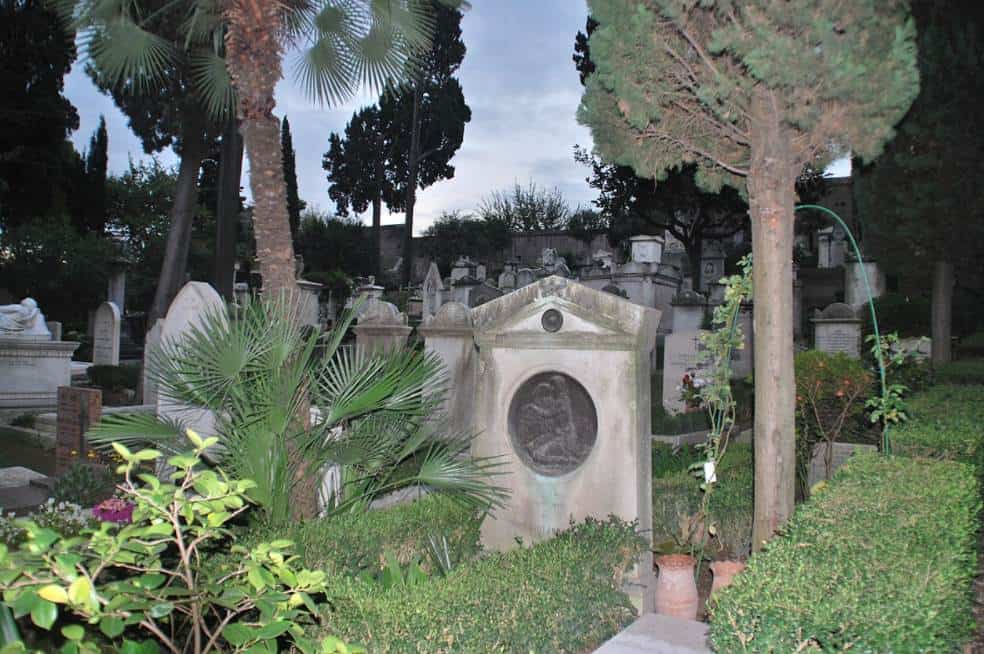
45. Palazzo Spada
Just a few blocks away from its famous counterpart known as the Palazzo Farnese you can find yet another palace known as the Palazzo Spada.
Originally commissioned in the year 1540, the palace ended up being bought by Cardinal Spada in the year 1632.
He commissioned famous Baroque architect Francesco Borromini to make changes to it, and what an astounding job he did!
He created a masterpiece of optical illusion in the form of a corridor that appears to be much longer than it is.
Even though our mind is tricked into believing that the rows of columns run a total of 37 meters (121 feet), in reality, the corridor is only 8 meters (26 feet) long.
At the end of the corridor, you can see what appears to be a life-sized sculpture, which only stands 60 centimeters (1.96 feet) tall.
Even though we give credit to Borromini for the design, he did get help from a mathematician while conceiving this marvelous masterpiece.
Apart from this remarkable feature, the palace also features a gallery with fine works of art (this was kind of expected, right?) including works by Titian, Jan Brueghel the Elder, and Rubens, to name just a few masters.
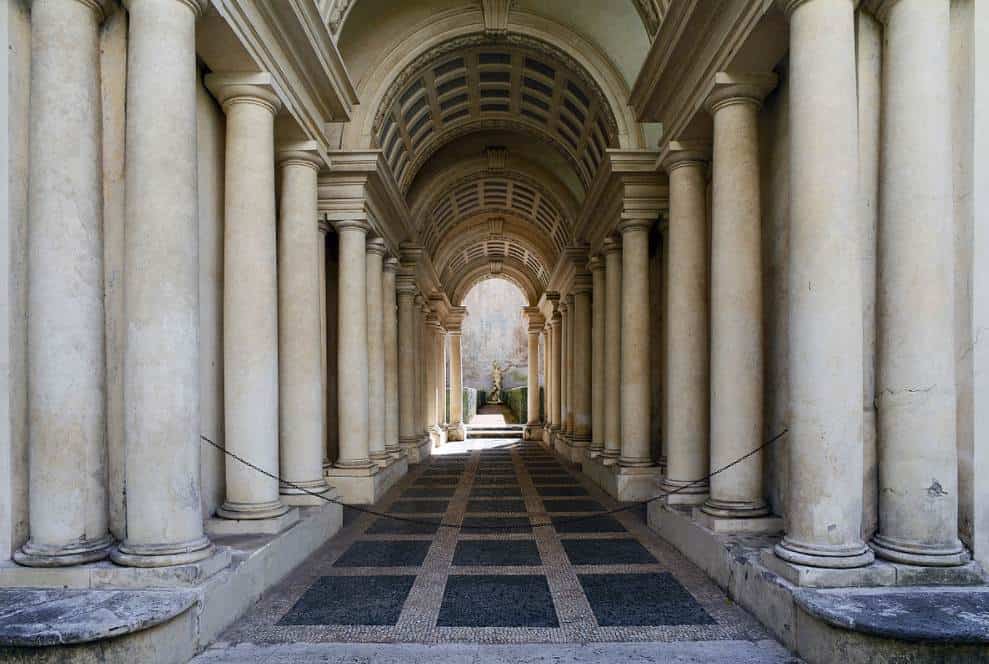
46. Chiesa del Gesù
The Church of the Gesù is the mother church of the Jesuits in Rome, one of the religious orders of the Catholic Church.
It is located just northwest of Capitoline Hill and is famous for featuring the first baroque façade in the city of Rome following its completion in 1584.
This makes it one of the most influential Jesuit churches and it served as the source of inspiration for countless other structures all around the world.
One of the most astounding features of the church is the ceiling fresco and interior of the dome. This work is known as “Triumph of the Name of Jesus” and was completed by the Baroque painter Giovanni Battista Gaulli (1639-1709).
The most striking element of the ceiling is the optical illusion known as the “trompe l’oeil effect.”
All you can do when entering the church is to look above and stand in admiration of what this man has achieved inside this building.
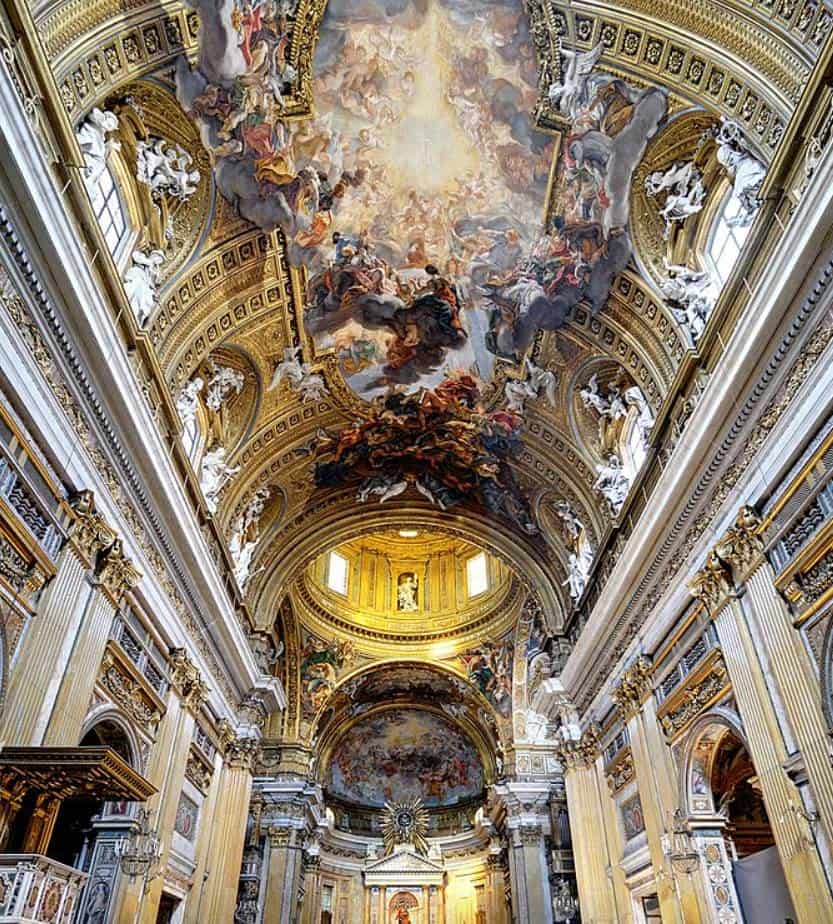
47. Museo di Roma
The Museo di Roma is one of the museums in the chain of civic museums in the city.
It was established during the fascist era in 1930 in an attempt to keep the history of the “old Rome” alive, but numerous bequests have turned it pretty much into a museum of fine art.
As expected, this museum is also housed in a former palace known as the “Palazzo Braschi.” This structure is situated between Piazza Navona and Campo de’ Fiori.
The neoclassical palace dates back to the early 19th century and was built by Luigi Braschi Onesti, the nephew of Pope Pius VI.
The original collection of the museum features about 5000 drawings, engravings, and old illustrated books, but now features works of some of the most famous artists in history.
Some of the highlights of the museum are paintings by English portrait painter Joshua Reynolds and sculptures by Antonio Canova.
Official website: Museo di Roma
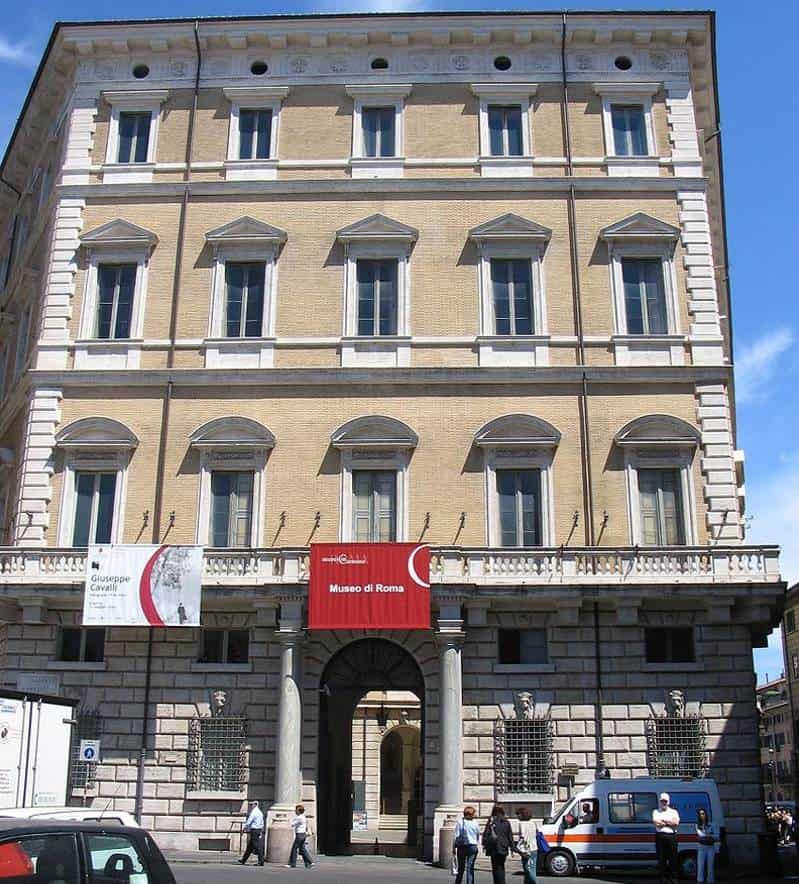
48. Santa Maria degli Angeli e dei Martiri
We already saw the architectural genius of Michelangelo with St. Peter’s Basilica and his transformation of the square on Capitoline Hill.
In our opinion, his work on Santa Maria degli Angeli e dei Martiri is at least equally impressive.
This 16th century was built inside the frigidarium of the ancient Baths of Diocletian, the largest bathing complex ever built in ancient Rome.
The exterior of the structure still features the ruins of this ancient entertainment facility. The interior, on the other hand, was transformed into a church based on a plan created by Michelangelo between 1563 and 1564.
The result is quite fascinating because you’re walking into a place that originally featured the cold bath of the Roman bathing complex.
You’ll surely realize at what kind of a scale ancient Roman structures were built when you enter this church.
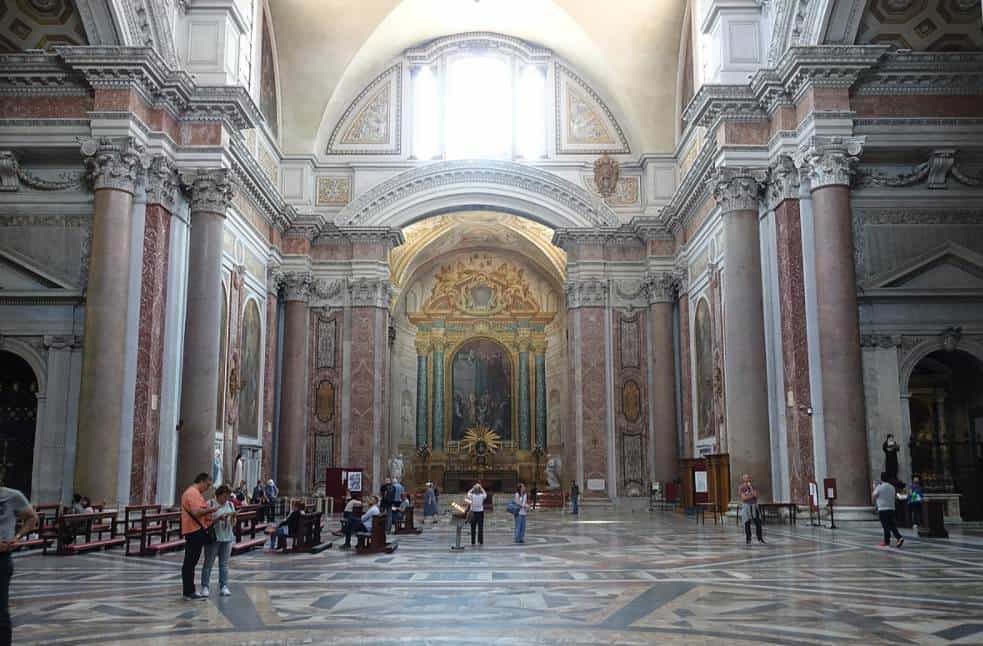
49. Palazzo Colonna
At the foot of Quirinal Hill, you can find an interesting palace complex of which the first version was constructed in the 13th century.
It wasn’t until the 17th century that the palace was transformed into the opulent Baroque palace we see today.
This renovation project was conducted by Filippo I Colonna (1578-1639), an Italian nobleman after who the palace was named.
It wasn’t until the 18th century that most of the decorations were completed. Especially the Colonna Gallery is a prime example of the extravagant decorations used during this period.
And what would a palace be without a collection of fine art, right?
The Galleria Colonna has several works on display from several famous artists, including Tintoretto, Bronzino, and Annibale Caracci.
Important note: the palace is only open for visitors on Sunday mornings.
Official website: Palazzo Colonna
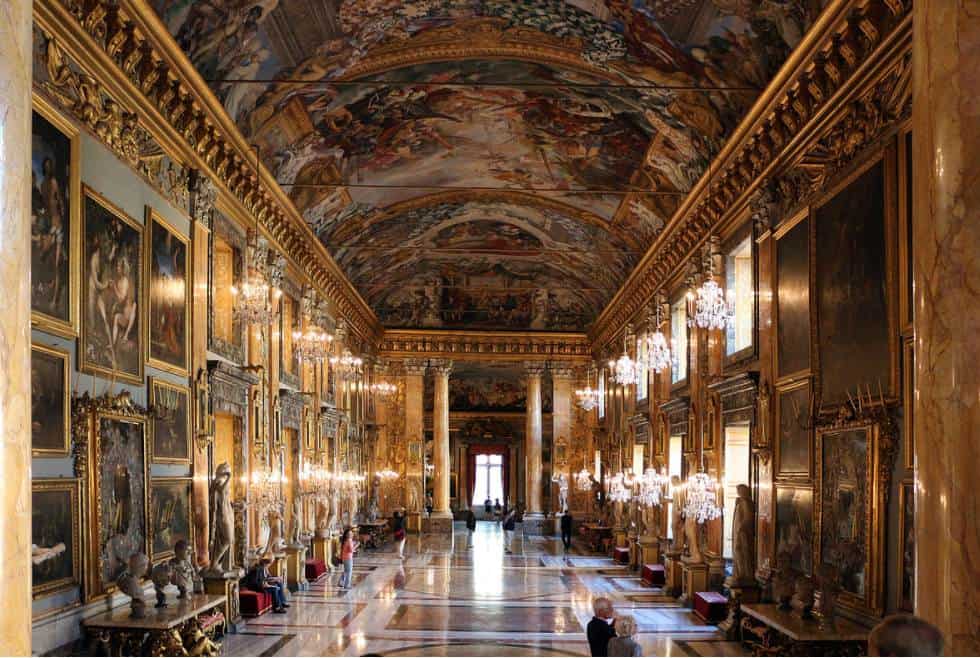
50. Catacomb of Callixtus
Many burial places are located beneath the city of Rome, collectively referred to as the “Catacombs of Rome.”
About 40 of these burial sites are known today, of which multiple have only been discovered recently.
Many of the burial places were reserved for Christians, but some also included followers of the Jewish and ancient Roman pagan faiths.
One of the most famous of all Roman Catacombs is the so-called “Catacomb of Callixtus,” renowned for being the location of the “Crypt of the Popes.”
This crypt dates back to the 2nd and 4th centuries and was the burial site of some of the earliest popes in history. It’s estimated that 16 popes and 50 martyrs were buried here.
The catacomb was named after Callixtus I, a man who was pope between 218 and 222 and who presumably initiated its construction.
Visiting this place takes you back to the earliest stages of Christianity, quite an astounding experience.
Official website: Catacomb of Callixtus
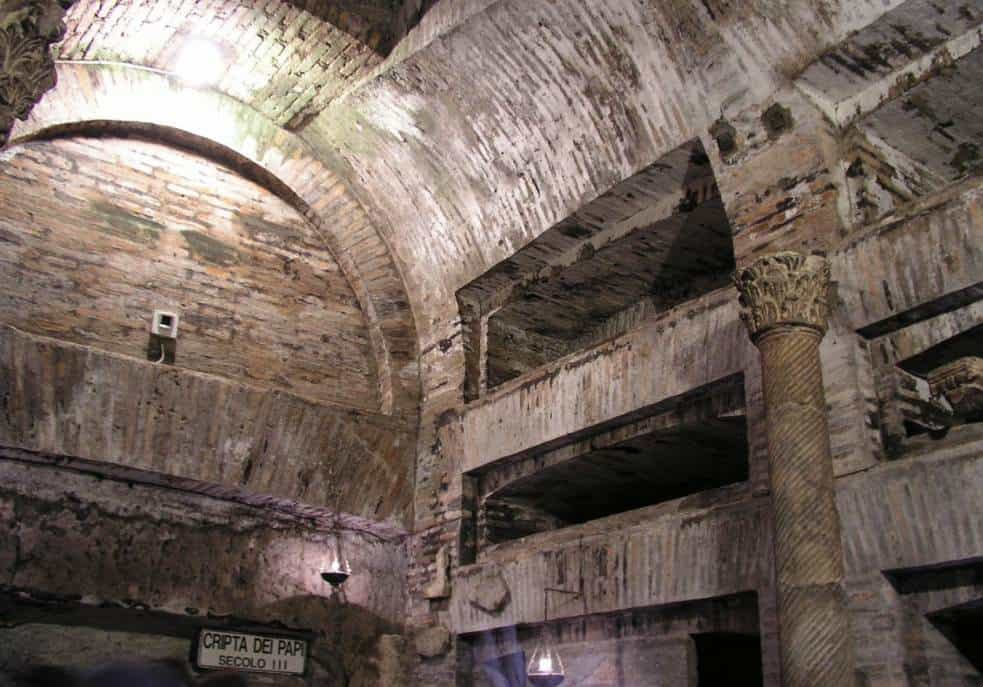
51. Chiesa di Sant’ Ignazio di Loyola’s dome
The Church of St. Ignatius of Loyola at Campus Martius is commonly referred to as “Sant’Ignazio” and was named after a Spanish Basque Catholic priest named Ignatius of Loyola (1491-1556).
He was the founder of the Society of Jesus in Rome, a religious order dedicated to missionary work and teaching.
This fascinating Baroque structure was built between 1626 and 1650 and is located just a few blocks east of the Pantheon.
One of the members of the Jesuit Order named Andrea Pozzo (1642-1709), a Baroque painter and architect, created one of the most amazing ceilings you’ll ever come across, and that means something in Rome.
He not only used the trompe-l’œil effect to paint the entire ceiling but also used it to create an optical illusion featuring a non-existing dome.
Yet again, all you can do is stand in awe of the amazing achievements one human being is capable of.
Official website: Church of Saint Ignatius

52. Museo dell’Ara Pacis
Right next to the Mausoleum of Augustus you can find another monument that dates back to the reign of the first Roman Emperor.
The Ara Pacis Augustae is an altar that was dedicated to “Pax,” the Roman goddess of peace.
This monument was built between 13 and 9 B.C. in honor of the emperor who had spent 3 years on a campaign in Hispania and Gaul. It was eventually inaugurated by the Roman Senate on January 30, 9 B.C.
Today, the Ara Pacis is located in a museum dedicated to this monument. The museum itself is a modern structure designed by American architect Richard Meier and made out of steel, travertine, and glass.
The fact that you’re admiring a monument that was dedicated over 2 millennia ago inside a modern structure is quite an amazing experience.
Official website: Ara Pacis Museum
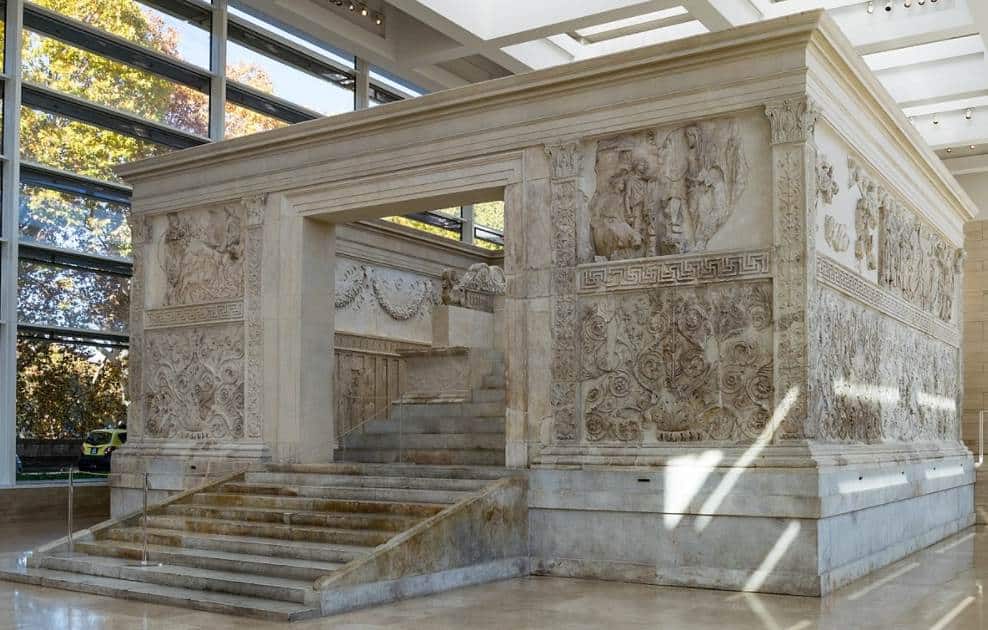
53. Chiesa di Santa Maria della Vittoria
Just northeast of the historical center of the city you can find yet another Baroque church called Santa Maria della Vittoria.
This church was built between 1608 and 1620 and is located right next to the Fontana dell’Acqua Felice, also known as the “Fountain of Moses.” This amazing landmark fountain was built between 1585 and 1588.
Just like most Baroque churches of the 17th century, the interior of this building can be described as highly decorative and extravagant.
It’s hard to imagine when you enter a breathtaking interior design like this one, but the highlight of the church is located in one of its chapels.
The so-called Cornaro Chapel features one of Gian Lorenzo Bernini’s ultimate masterpieces called “Ecstasy of Saint Teresa” (1647-1652).
Admiring this work of art is reason enough to take a visit to this church.
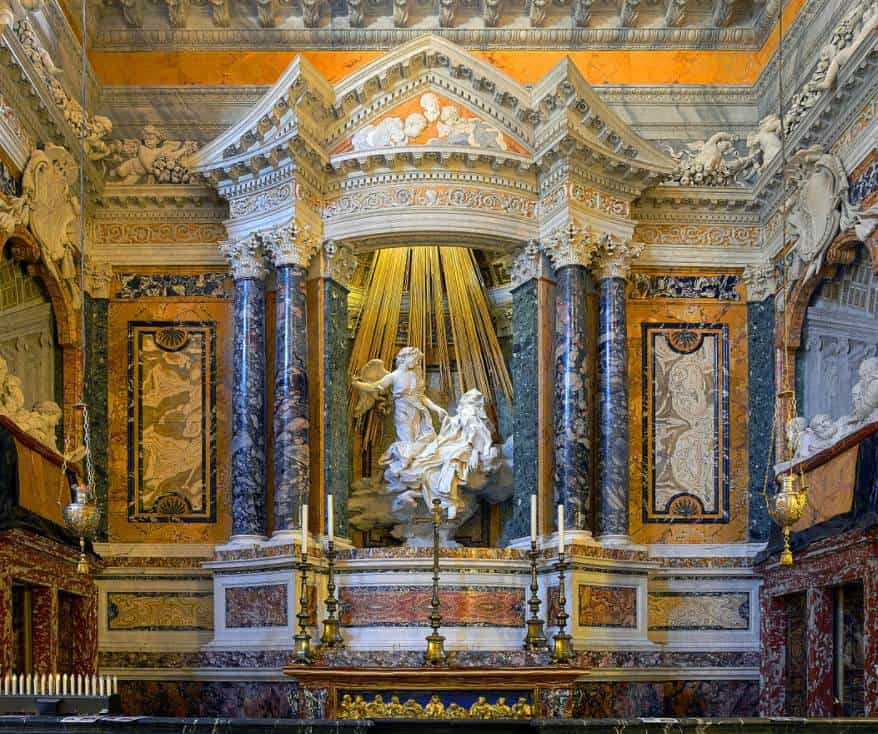
54. San Pietro in Vincoli
If you want to visit yet another masterpiece by one of the most famous artists in history, then you can head over to San Pietro in Vincoli, a minor basilica located just north of the Colosseum.
This church is the location of the tomb of Pope Julius II, the patron of the arts who engaged famous artists such as Raphael, Leonardo da Vinci, and Michelangelo during their stay in Rome.
This was supposed to have 47 statues according to Michelangelo’s original plan, but the statue of Moses, completed in 1515, eventually became the centerpiece.
The tomb was finally completed in 1545, even though the Pope had died way back in 1513.
Regardless, the statue of Moses is considered to be one of Michelangelo’s greatest achievements and can be admired in this church.
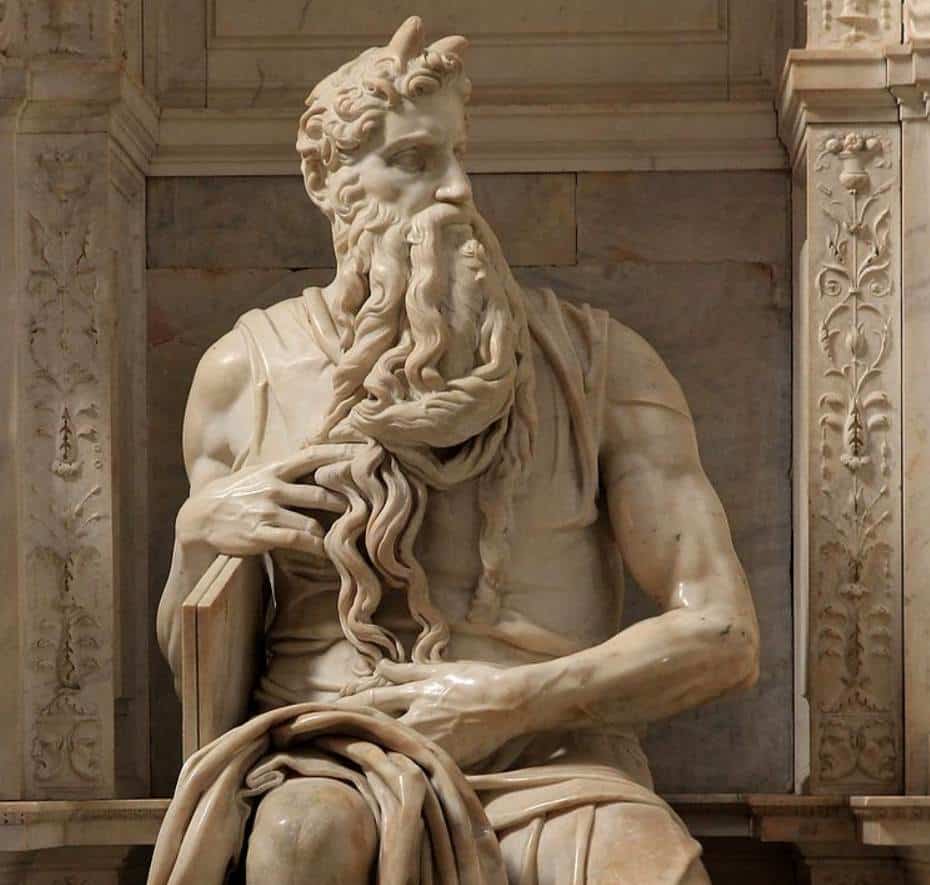
55. Largo di Torre Argentina
In the heart of the city, just south of the Pantheon, you can find a square that used to be the location of 4 Roman Republican-era temples and the immense Theater of Pompey.
Another remarkable fact about Largo di Torre Argentina is that it’s believed that this is the location where Julius Caesar was assassinated. This happened in the Curia of Pompey, a Roman meeting hall that once stood here.
Today, the square is pretty much dominated by the ruins of the ancient structures that once stood here over 2,000 years ago.
The so-called Temple D on the square is also used as a cat shelter, an initiative to save cats that started in the year 1993.
If you’re a cat lover, then seeing these cuddly creatures roaming around the ruins of ancient Roman temples will be quite amazing for sure!
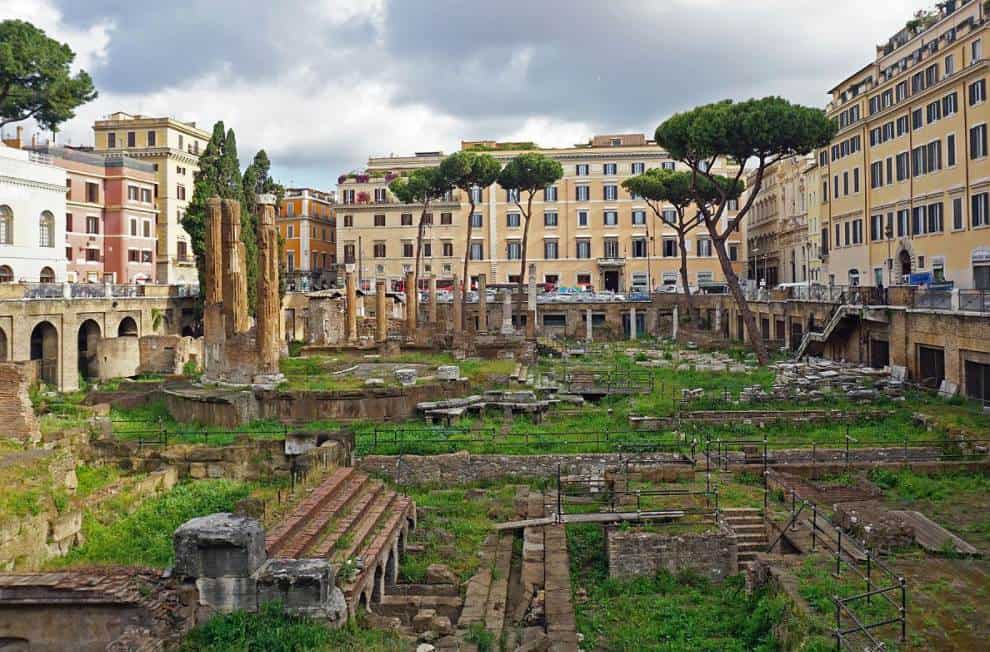
56. Centrale Montemartini
Admiring ancient sculptures is something you can do in multiple museums in Rome. What you can’t do in any other place is see these lined up in a former powerplant.
That’s exactly what you get at Centrale Montemartini because these ancient Roman works of art are situated in what used to be a facility to generate power for Roman citizens.
The museum opened its doors in the year 1997 and houses part of the sculpture collection of the Capitoline Museums.
The museum features 4 main galleries named the Atrium, the Hall of Columns, the Hall of the Machines, and the Boiler Room.
The museum is located in the Ostiense neighborhood just south of the center of the city and is most definitely worth a visit.
Official website: Centrale Montemartini

57. Santa Maria Sopra Minerva Basilica
Just one block east of the Pantheon, in Piazza della Minerva, you can find the only example of an untouched Gothic church in Rome.
Santa Maria Sopra Minerva is a major Dominican church and even though it’s behind a Renaissance-style façade, it still features the same Gothic interior as the year it was consecrated in 1377.
The arched vaults of the church are painted blue and gilded, an element that transforms this church into a remarkable Gothic masterpiece.
Elaborately decorated chapels and a sculpture of Christ the Redeemer by Michelangelo make this yet another interesting building to enter during your stay in Rome.

58. Basilica Parrocchiale Santa Maria del Popolo
One of the most important churches in Rome is located on the Piazza del Popolo, the large urban square that marks the northern entrance to the city.
This was the first church that visitors to Rome coming from the north encountered and marked the starting point of the Via Flaminia, a major ancient road leading to Rome.
It also became the favorite church of Pope Julius II, and as a major patron of the arts, he decorated the interior with numerous works of art.
The extremely realistic portrait of Pope Julius II, painted by Raphael, was put on display here following his death in 1513 as well.
Some of the most remarkable works of art inside the church are “The Conversion of Saint Paul “and “The Crucifixion of Saint Peter” by Carravaggio.
Both are located in the Cerasi Chapel, along with a work by Annibale Carracci, and are a must-see if you’re into fine art (and even if you’re not, you’ll surely appreciate the talent of this remarkable Baroque painter).
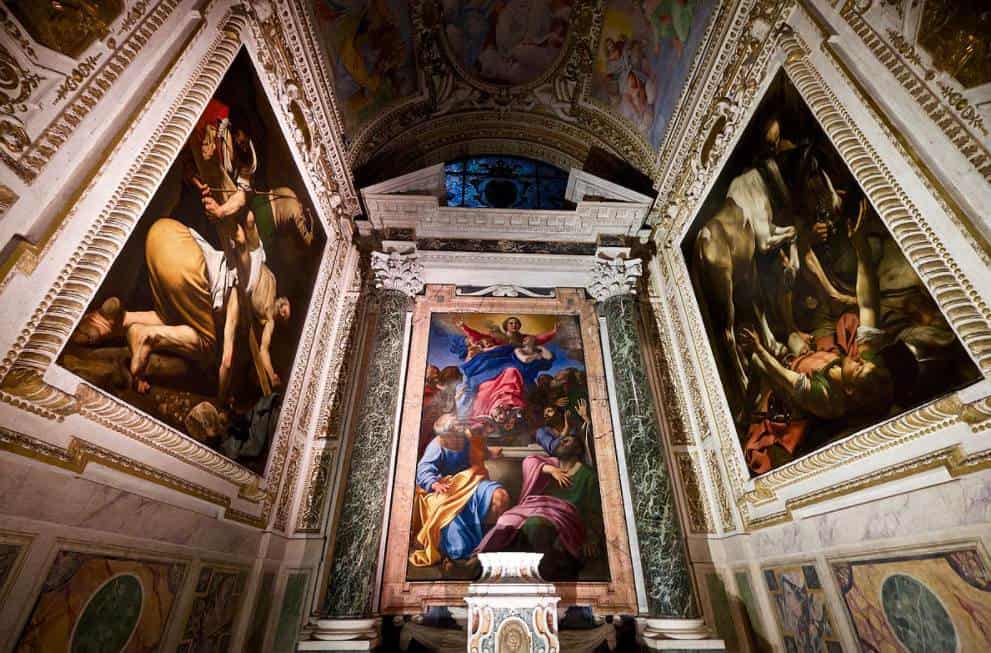
59. Visit the huge Quirinal Palace
We already covered several palaces in Rome, but none come even close in size to the Quirinal Palace.
It’s located on top of Quirinal Hill, the highest of the 7 historic hills in Rome. It covers an area of 110,500 square meters (1.19 million square feet) which makes it the 11th-largest palace in the world.
Originally built in the late 16th century by Pope Gregory XIII as a summer residence, the palace was seriously expanded in the following decades.
The sheer size of this palace nearly turned it into the official residence of Emperor Napoleon Bonaparte, but because of his defeat in 1814, this never happened.
Today, the building serves as one of the three official residences of the President of the Italian Republic.
Some parts of the palace are open for tours and there’s also a museum that can be visited.
Official website: Quirinal Palace
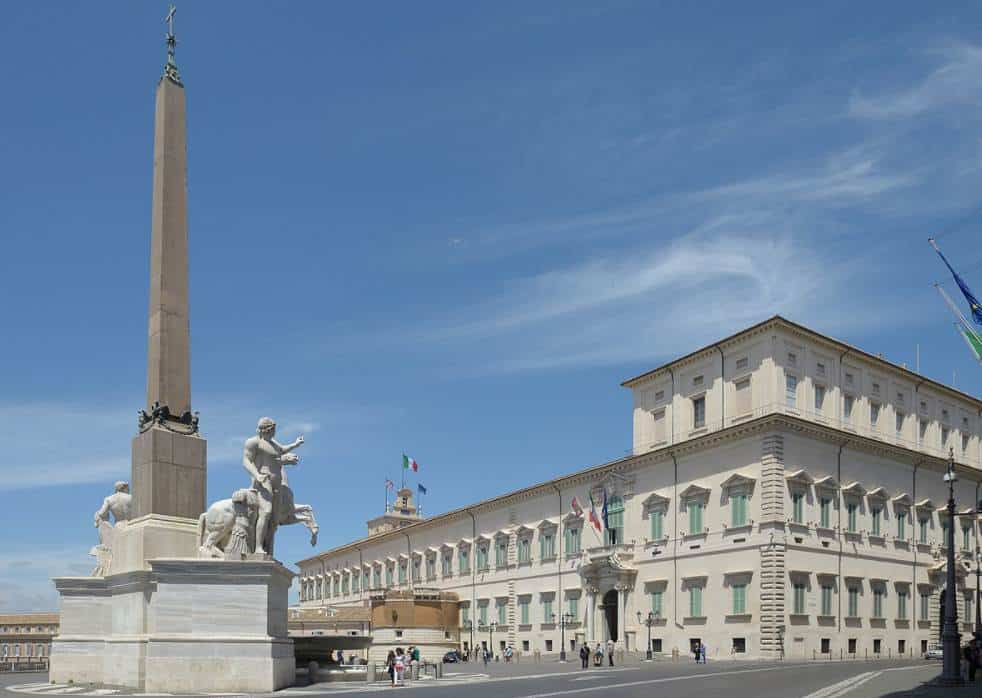
60. Basilica Papale San Paolo Fuori le Mura
Basilica Papale San Paolo Fuori le Mura or “Basilica of Saint Paul Outside the Walls” is another church located on Italian territory but owned by the Holy See in Vatican City.
It’s one of the most fascinating structures in Christianity, mainly because it was founded by Roman Emperor Constantine I on what is believed to have been the burial site of Saint Paul.
The original followers of Christianity first built a memorial on the place he was buried in his honor. The first Basilica on this location was consecrated in the year 324, quite a while ago.
Between 2000 and 2006, excavation works were conducted, and the actual sarcophagus inside the Tomb of Saint Paul was discovered.
Radiocarbon dating of the remains further uncovered that they date from the 1st or 2nd century.
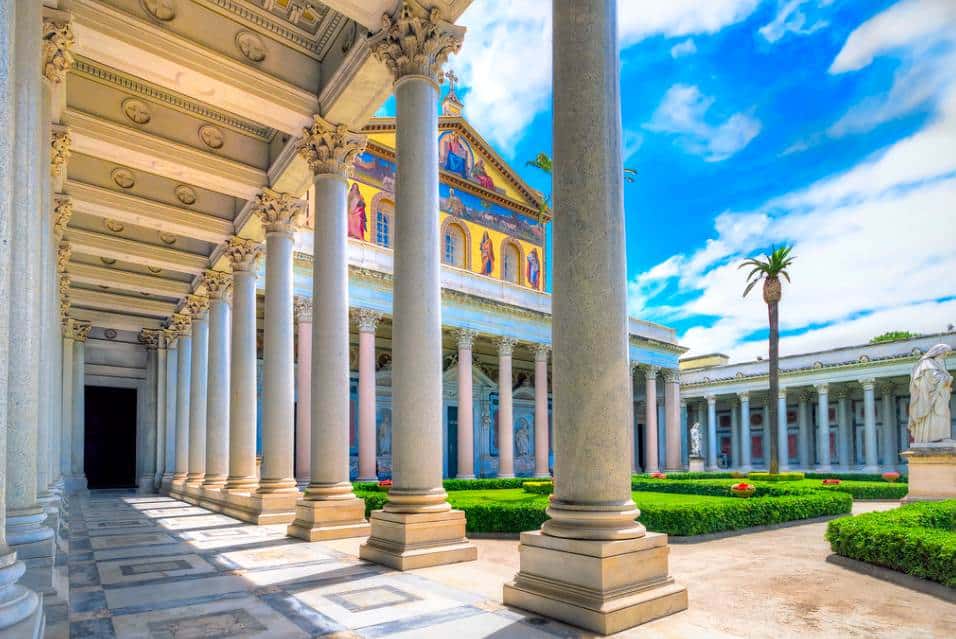
61. Archbasilica of Saint John Lateran
Just when you think that you have seen it all in Rome, another surprise pops up. That’s exactly the case with the Archbasilica of Saint John Lateran.
Of all the churches we have seen already, this is considered to be both the oldest and the most important one.
Originally founded in the year 324, it has become the highest-ranking Roman Catholic church and is the seat of the Bishop of Rome.
The ancient church was completely rebuilt during the 16th century under Pope Sixtus V. The interior was completed in the 17th century and the façade was completed in the year 1735.
